‘A way for administration to publicly humiliate the Motley’: Coffeehouse tasked with policy changes after complaints
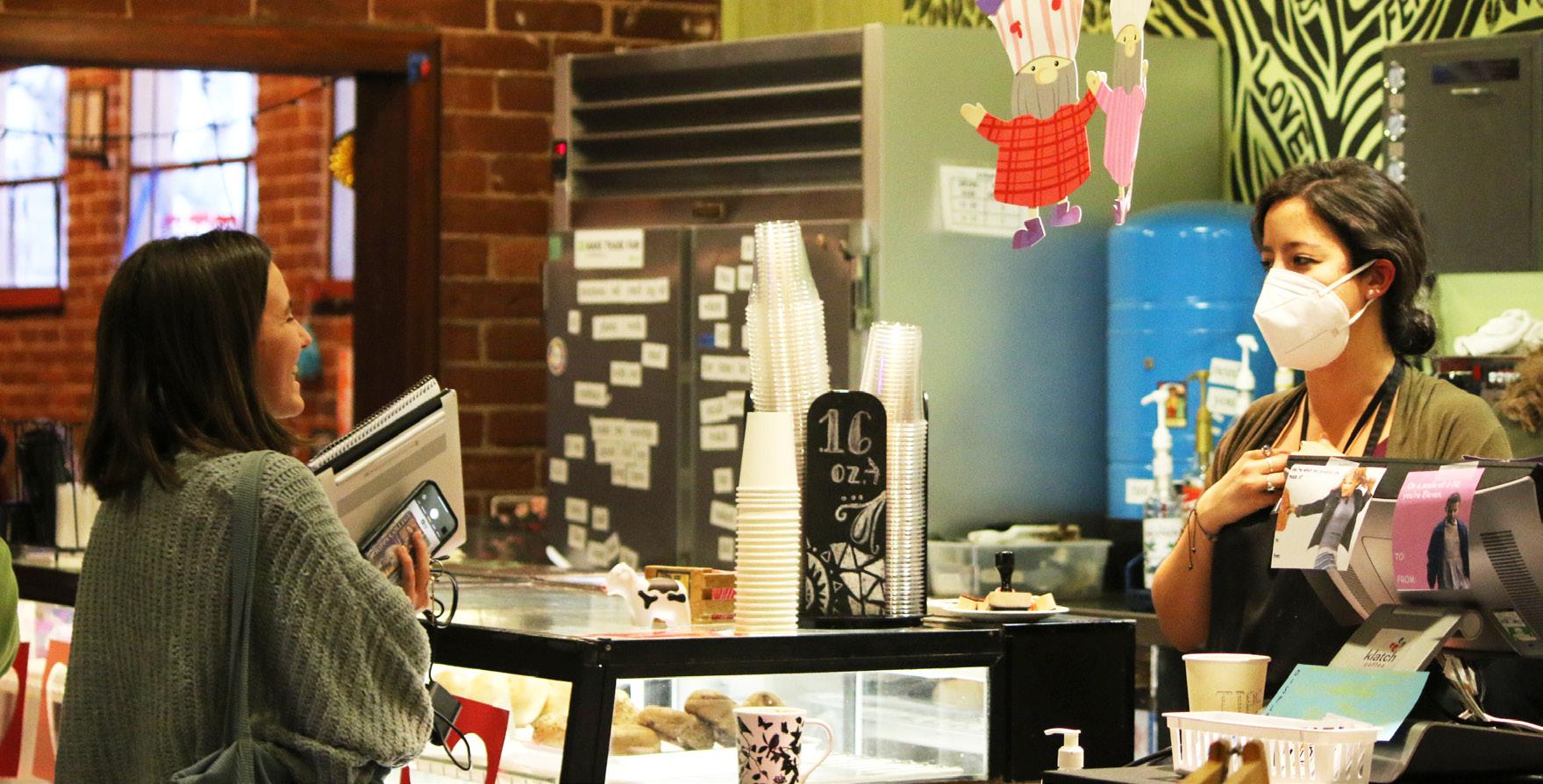 ANNABELLE INK
ANNABELLE INK
On Jan. 19, the management team at Scripps College’s Motley Coffeehouse met with their staff advisor, Adriana di Bartolo-Beckman, to address a series of complaints made the previous semester about “pro-Palestinian activity” at the Motley.
According to one student manager, who asked to remain anonymous in order to maintain job security, the complaints mainly came from faculty members and Scripps alumni who felt that pro-Palestinian activity at the Motley had turned the space into one in which “not everyone [felt] welcome.”
The complaints followed a burst of protests, vigils, statements and teach-ins that dominated the 5C community during the fall semester in response to
the Israeli government’s ongoing siege in retaliation to Hamas’ Oct. 7 attack on Israel; since then, over 25,000 people in Gaza have been killed.
In criticizing the Motley — where students hung a variety of posters reading “Free Palestine” in support of Palestinian liberation and campus organization, Claremont Students for Justice in Palestine (SJP) hosted several events, including educational and solidarity-focused gatherings earlier in the academic year — the complaints suggested that the student-run coffeehouse had adopted a pro-Palestinian stance that contributed to a hostile environment on campus.
Responding to these complaints, di Bartolo-Beckman, who also serves as assistant vice president for Student Affairs and Dean of Students Office See MOTLEY on page 3
at Scripps, provided Motley managers at the Jan. 19 meeting with a list of demands that they were expected to meet before the Motley’s reopening in early February. These demands included creating a new meeting request form, enforcing the college’s posting policy within the Motley, and releasing a statement of inclusivity. Some students felt that these demands reflected attempts by Scripps administration to limit or control pro-Palestinian activism on campus. A second student manager who was present at the Jan. 19 meeting explained that, while di Bartolo-Beckman communicated the demands with the Motley’s management team, she did not necessarily
Brian Davidson remains Ath acting director after Priya Junnar steps down
JUNE HSU
Brian Davidson CM ’08 will continue as Claremont McKenna College’s (CMC) acting director of the Marian Miner Cook Athenaeum, informally called the Ath, following long-time director Priya Junnar’s decision to step down at the beginning of this semester.
Heather Antecol, dean of the faculty at CMC, made the announcement in an email sent Jan. 16. The email noted Junnar’s accomplishments during her time as director of the Ath and thanked her and Davidson for their service. Davidson assumed the role of acting director of the Ath in July 2023, when Junnar announced her leave of absence for the fall semester. This announcement came several hours after CMC President Hiram Chodosh, who is married to Junnar, shared his plans to take a sabbatical and return in January 2024.
In addition to being a CMC alumnus, Davidson was previously a part of the Athenaeum
Advisory Committee and served as one of the Buzz Woolley Athenaeum Fellows, a group of students who suggest ideas for and help coordinate the Ath’s programming.
The director is responsible for organizing the Ath’s weekly schedule, which features talks from public figures such as scholars, artists and innovators and includes a lunch or dinner program for 7C community members.
The Ath is described as “a distinctive feature of social and cultural life at CMC” on the College’s website, providing students with an opportunity to ask questions after each presentation or dine with the speaker at the head table. Since she began her position in 2014, Junnar has hosted numerous notable speakers, including Tom Steyer and Cornel West in 2023. During her time as director, Junnar brought greater engagement from the wider consortium to the Ath. Former Athenaeum Fellow Rukmini Banerjee CM ’24 described Junnar’s ability to create community within the space.
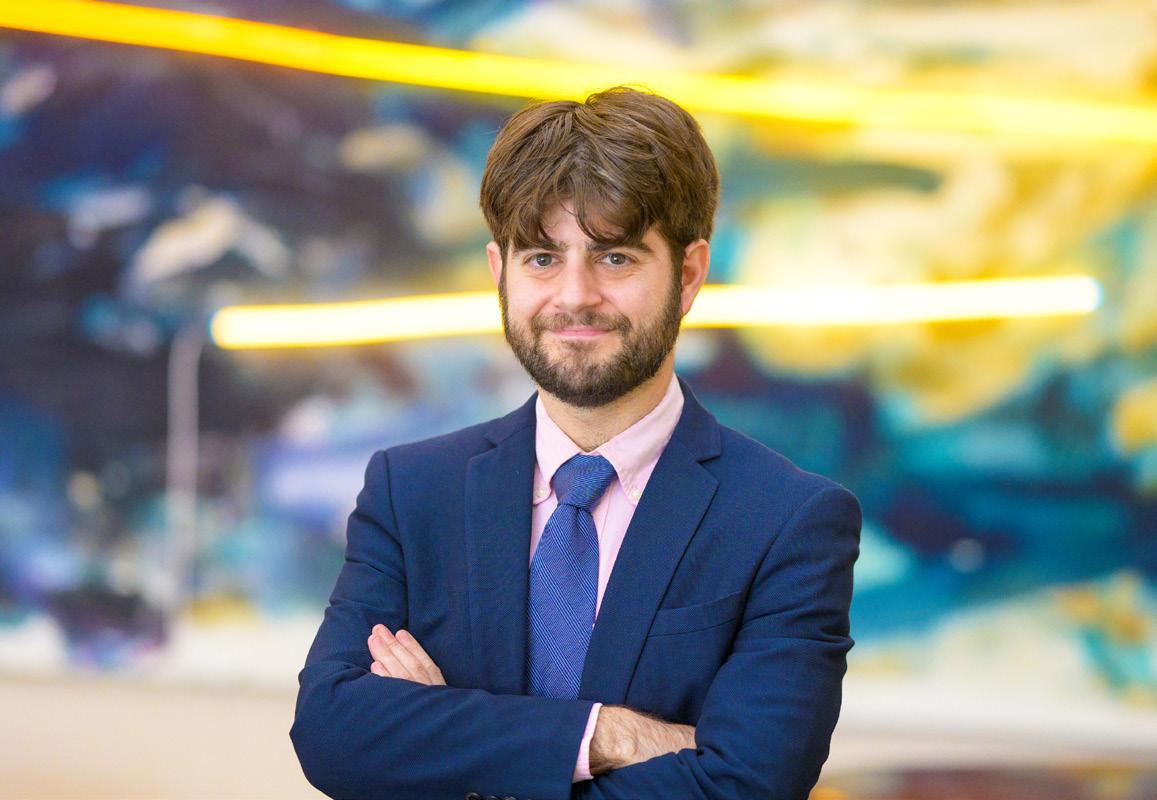
Mobilizing, finding hope and having courageous conversations: Linda Sarsour’s discussion on Palestinian Liberation
CAIDEN SEARCY & KAITLYN ULALISA
On Thursday, Jan. 25, Pomona Student Union (PSU) hosted renowned author and activist Linda Sarsour for “A Discussion on Palestinian Liberation.” Zyad Sibai PO ’25, co-vice president of PSU development and operations, moderated the talk, which took place at Pomona College’s Rose Hills Theatre and featured a lively group of students and faculty members.
Sarsour’s discussion comes in response to Israel’s continued assaults on Gaza, which have escalated in retaliation to Hamas’s attack on Israel last October. Since then, over 25,000 people have been killed in Gaza and over 60,000 wounded. On Dec. 29, 2023, South Africa asked the International Court of Justice (IJC) to call for the prevention of what they described as “genocidal in character” by Israel in Gaza. The court has since ruled on Jan. 26 for “Israel to take steps to prevent acts of
genocide in Gaza but stopped short of ordering a ceasefire.” At the 5Cs, Israel’s siege on Gaza has prompted a series of
protests and teach-ins at the 5Cs led by activists standing in solidarity with Palestine and calling for Pomona’s di -
vestment from Israel.
In addition to discussing what Sarsour described as an urgent need for the safe -
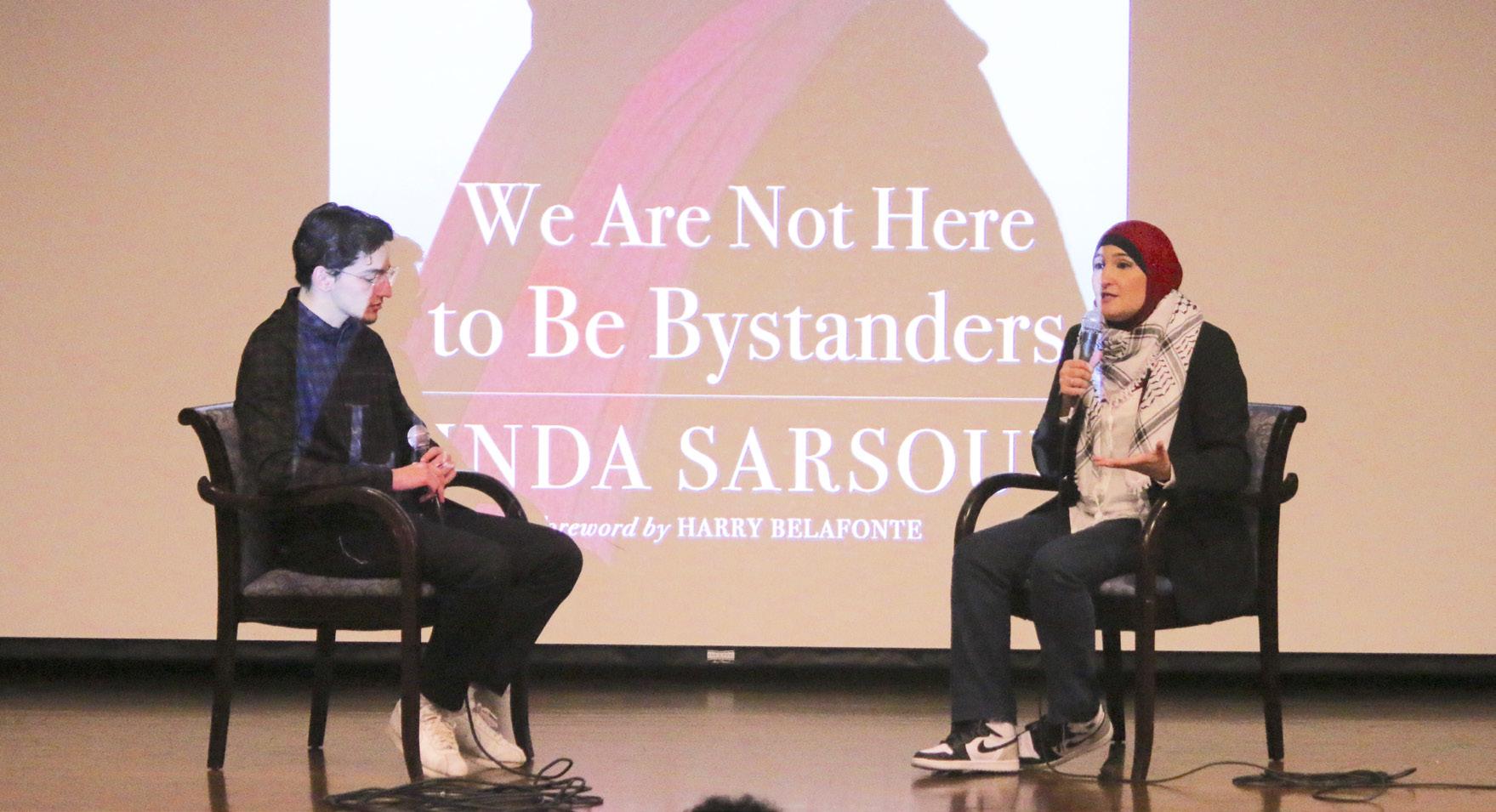

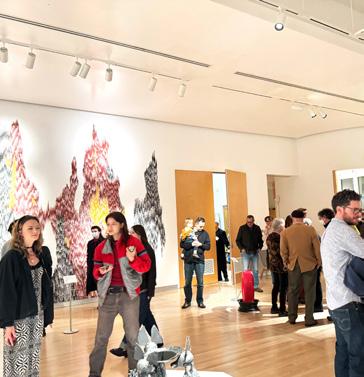
Dining Hall Lore


ty and security of Palestinians, the speaker emphasized the importance of encouraging student mobilization, holding courageous conversations and finding the strength to fight for one’s beliefs.
The discussion began with Sarsour sharing the experiences that led her to become an activist.
“My aspirations and dreams were to be a high school English teacher,” Sarsour said. “And then the horrific attacks of 9/11 happened in New York, the city I was born and raised in.”
Following this pivotal moment, Sarsour became a translator, deciding to use her fluency in both Arabic and English to help Arabic-speaking immigrants navigate the American legal system. Since then, she has risen in recognition and influence, having served as one of the National co-chairs of the Women’s March on Washington in 2017.
See SARSOUR on page 3



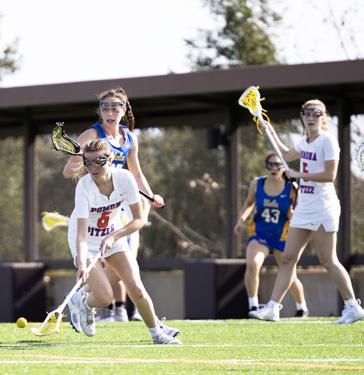
The student newspaper of the Claremont Colleges since 1889 INDEX: News 1 | Arts & Culture 4 | Opinions 7 | Sports 9 FRIDAY, FebRuARY 2, 2024 CLAREMONT, CA VOL. CXXXV NO. 11 ARTS & CULTURE OPINIONS SPORTS The 79th Ceramic Annual at Scripps College’s Ruth Chandler Williamson Gallery explores the theme “The Idea of Feeling Brown.” The exhibit features 13 artists who define narratives of brownness beyond trauma through augmented reality and performance experiences. Last weekend, Jacob Elordi’s visual allure enticed audiences to Saturday Night Live’s (SNL) comedic stage and Grace Kim SC ’27 is thoroughly disappointed. The D1 UCLA Bruins unleashed the beast in a sudden death defeat of Pomana-Pitzer Women’s lacrosse in the preseason opener, winning 12-11 but allowing the Hens to showcase their skills as they prepare for the 2024 season.
WeNDY ZHANG • THe STuDeNT LIFe
COuRTeSY: ANIbAL ORTIZ
ATH
brian Davidson CM ’08 will take over the role of CMC Athenaeum Director after Priya Junnar announced her decision to step down Jan. 16.
See
on page 2
WeNDY ZHANG • THe STuDeNT LIFe
Some student managers at the Scripps Motley Coffeehouse expressed frustration over new policy changes that the business was asked to implement.
On Jan. 25, Pomona Student union hosted renowned author and activist Linda Sarsour for A Discussion on Palestinian Liberation.
SCAN TO LISTEN
TSL x KSPC Presents…
The 5C dining hall experience is about so much more than the food. Not only a prime subject for small talk and hot takes, the spaces themselves are cultural and historical hubs. Join hosts Abbie and Hannah as they dive into the trials, tribulations and triumphs of 5C dining.
LISTEN
Podcast Episode #1
SCAN
Hosts: Abbie Bobeck SC ’26 & Hannah Weaver SC ’24
Meet TSL’s spring 2024 editorial board
ANNABELLE INK
With the spring 2024 semester in full swing, Ben Lauren PZ ’25, Ansley Washburn SC ’26 and Elena Townsend-Lerdo PO ’26 have officially taken over TSL’s editorial board. Elected last December by members of the previous editorial board along with a larger hiring committee consisting of TSL senior staff, the trio will help guide more than 100 staff members over the next five months as they continue to put out a weekly paper at the Claremont Colleges. Lauren, TSL’s editor-in-chief, is an English and Media Studies major from New York City. His involvement in journalism extends all the way back to his freshman year of high school, although it has far from faded in the years since.
In addition to holding the position of editor-in-chief at Pitzer College’s “The Outback,” Lauren has previously served as both a sports editor and a managing editor at TSL. Reflecting on his work last semester as managing editor of Sports and Arts & Culture, Lauren explained that he was excited to return and continue the work that he started.
“One thing that I learned last semester was that it is kind of difficult to accomplish all the things you want to accomplish in one semester,” he said. “I really wanted to step into this higher position to take charge of some of the ideas that I and also my other two members of ed. board last semester started.”
In saying this, Lauren referred in part to TSL’s Diversity, Equity & Inclusion (DEI) committee, which was established last summer as part of an initiative to create a more
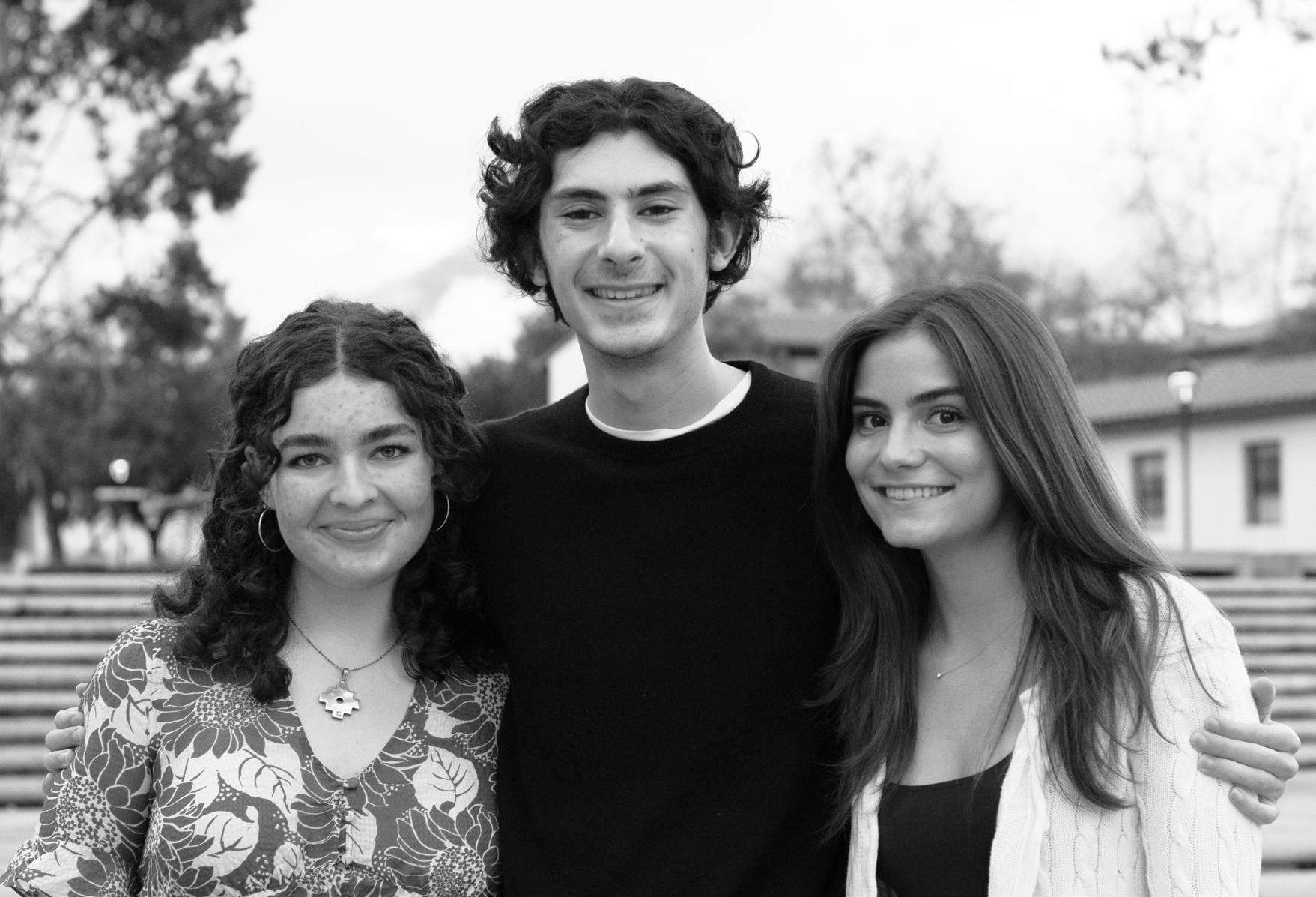
supportive and diverse community both in the newsroom and in the greater 5C community. This semester, Lauren hopes to expand the DEI committee and to give it more structure. Washburn, who will serve as this semester’s managing editor of News and Sports at TSL, is a prospective Politics major originally from Boston. Having served as a sports editor at TSL for the last three semesters, Washburn described TSL as being an integral part of her college experience.
MOTLEY:
Coffeehouse tasked with policy changes
Continued from page 1
appear to be the one behind them.
“When we asked her about it, she said it was from people above her,” the manager said. “She didn’t clarify who, but it definitely wasn’t her directly.”
The manager expressed her frustration with what she viewed as the administration’s attempts to stifle pro-Palestinian organizing on campus, arguing that the Motley is an inherently political space in which students are encouraged to share their views, even if said views are not unanimously agreed upon.
Indeed, the Motley has served as a hub for political discourse and student activism on campus since its inception back in 1974. In its mission statement, the Motley states its aim to offer students a space to engage in productive discussions and participate in community events.
“The Motley’s mission is to provide a center for intersectional feminist dialogues, highlight local vendors and sustainable global supply chains and support on-campus organizations through community events and sponsorships,” the statement reads.
The manager highlighted the political nature of this mission statement and suggested that the new policies being enforced at the Motley raise concerns of censorship on campus.
“I think it’s pretty ridiculous that administration would try to invoke this kind of censorship on the Motley,” she said. “The Motley has always been a political space and it’s never really tried to oppress any sort of political viewpoint.”
The demands introduced by di Bartolo-Beckman, however, imply that this perspective is not shared by all members of the Scripps community.
One of the demands required the Motley to create a new meeting request form for student groups seeking to hold recurring meetings in the space. The student manager stated that this demand was likely made in response to the weekly meetings of SJP last semester, which were held from 8 p.m. to 9 p.m. on Tuesdays.
The student manager, who explained that the Motley already had a meeting request form last semester and that SJP had submitted it in order to reserve their weekly time slot, expressed some confusion over the purpose of creating a new form. The manager expressed frustration about where she felt the demands were coming from.
“There’s really been nothing preventing other groups from being able to apply for weekly club meetings or events and such,” she said. “We don’t think that administration really has set up these demands very well and they’re just kind of reacting to the backlash they’ve received from alumni and faculty. I don’t think they know how our events work because [the new meeting request form] is basically the same [as the
old one].”
The student manager further suggested that this perceived lack of substance within the recent demands implies that the Scripps administration has ulterior motivations for enforcing them. She specifically highlighted the statement of inclusivity — which she described as being a “public apology” — that the Motley head managers were asked to create and hang within the space.
“It’s just kind of a way for administration to publicly humiliate the Motley and use it as an example because a lot of other organizations on campus, like the Scripps Store and dance department, have had a lot of similar backlash and struggles,” she said, noting that those organizations had not been asked to release a statement. According to di Bartolo-Beckman, however, the statement and the new policies being enforced at the Motley are meant to promote inclusivity within the space.
“The Motley has always and will continue to be an inclusive space where all Scripps students, staff, faculty and alums are welcome to meet, connect and collaborate,” di Bartolo-Beckman wrote in an email to TSL.
Both student managers commented on how the new demands would affect the Motley’s staff, specifically commenting on the poster policy. While students were previously free to hang up whatever posters they chose to in the Motley, all posters now have to be approved by the Office of Student Engagement beforehand. Any posters that do not comply with these regulations must be removed by Motley staff members.
“We told [administration] that we weren’t comfortable with that,” the second manager said. “They kind of replied that they didn’t feel comfortable or safe taking out posters either … they kind of just started pushing those demands and safety risks on students instead of the administration.”
Despite criticisms of these new demands by the Motley’s staff members, the student manager explained that they had to satisfy them.
“In the end, the situation is that we have around 40 employees, not including the managers, and [administration’s] demands are kind of strict in that they won’t let us open unless we follow through,” she said. “It’s kind of hard for us to do anything else.”
As long as the Motley’s management team satisfies the demands, they plan to host an opening night party on Thursday, Feb. 8 and to resume regular hours the following day.
“I came in first semester freshman year and have watched myself grow [at TSL] and have really started to love it,” she said. “I think I really love working with people at TSL and meeting new people from around the 5Cs and it’s just become a really great community. For me, that kind of defines my college experience and I’ve loved that.”
Townsend-Lerdo, TSL’s new managing editor of Arts & Culture and Opinions, is a prospective History major from San Francisco.
In the past, Townsend-Lerdo has served as both opinions editor and special projects editor at TSL. Passionate about college journalism, she expressed her excitement at being on this semester’s editorial board.
“I think [college journalism] is super important because it holds a lot of potential to present accurate news and to hold institutions of power accountable,” Townsend-Lerdo said. “[The college newsroom] is a really cool space where we can have that
coverage.”
Lauren noted that this semester’s editorial board differs from previous editorial boards in that their experience lies largely outside of News and is centered more so around the Sports, Arts & Culture and Opinions desks.
“I think we’re kind of bringing a new perspective to ed board that we maybe haven’t seen in a long time,” Lauren said.
Taking advantage of this perspective, this semester’s editorial board hopes to elevate all sections of the paper and promote unity and collaboration within TSL.
“Previously, we’ve been pushing for excellence in our respective sections and have maybe missed out on opportunities to maximize relevance and timeliness by working together,” Townsend-Lerdo said.
In addition to this goal, TSL’s new editorial board is looking to expand the publication’s Business and Social Media desks.
“Social media is the main way that our students actually engage with our content and it’s something, in the past, that we haven’t prioritized as much,” Washburn said. “We want to be able to cater to our audience and really have them engage in the way that they want to engage.”
Lauren expressed his confidence in the ability of this semester’s editorial board and overall staff to reach these goals and grow the paper as a whole.
“I think we’re already putting together a really strong team,” he said. “We have a lot of interesting, diverse viewpoints [across our staff] this semester, I think maybe even more so than any semester has had in the past.”
“Stop harboring daydreams”: At CMC, professors discuss war in Gaza
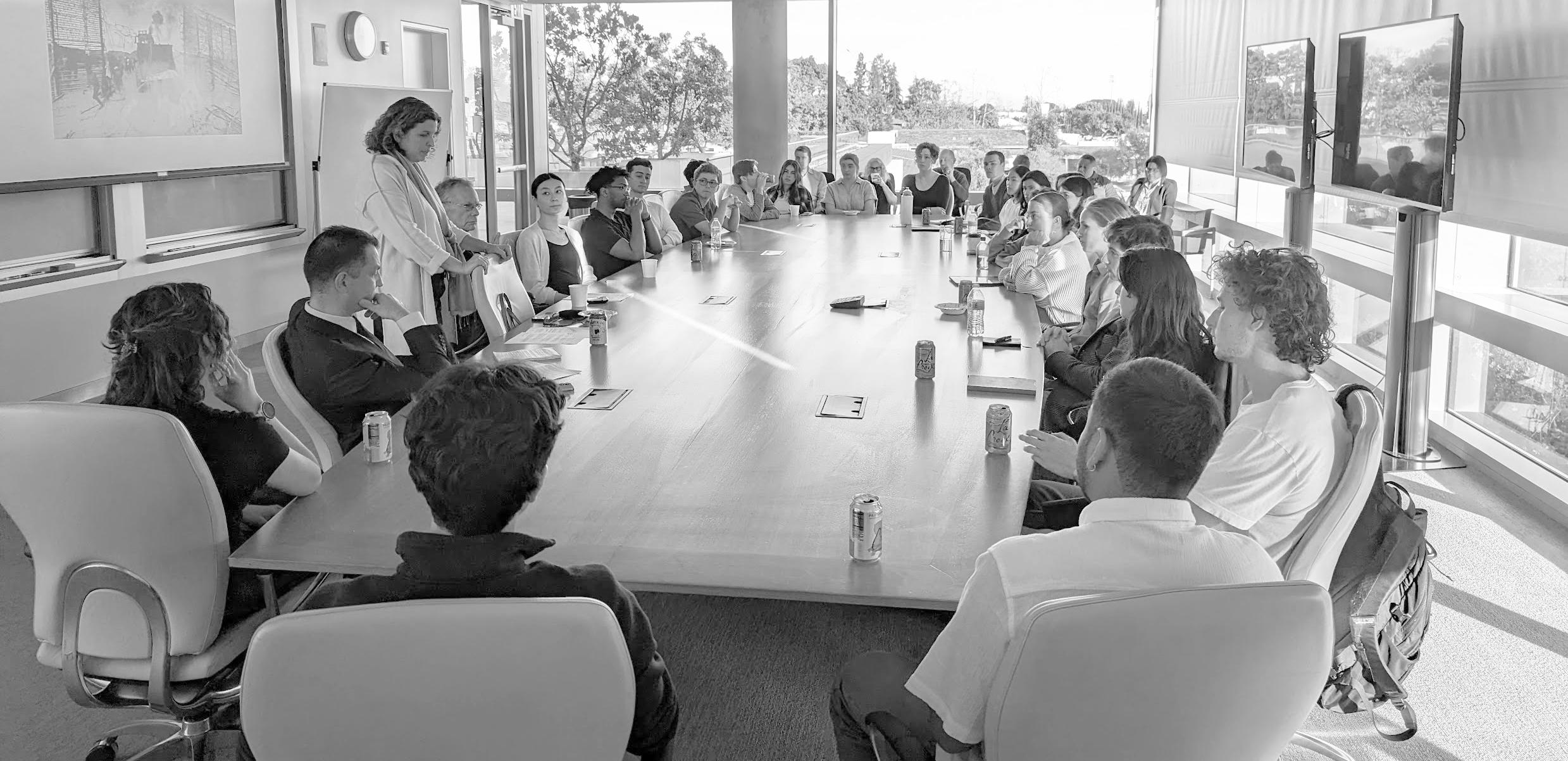
On Jan. 27, Claremont McKenna College’s (CMC) Open Academy and Keck Center Institute for International and Strategic Studies hosted a discussion facilitated by professors Heather Ferguson, Jon Shields and Hilary Appel titled “The War in Gaza.” The conversation, which was initially held at the Kravis Center, continued at Appel’s home later that evening over a Syrian dinner of fattoush salad, pita, hummus and falafel provided by Claremont Canopy.
UCLA Professor James Gelvin initiated the discussion by providing some context for the conflict in Gaza, referencing Palestinian militant group Hamas’ Oct. 7 attack in Israel.
“We can only guess about Hamas’s motivations on what it has done,” he said. “One of the reasons Hamas did this might have been to keep the Palestinian issue on the front burner of international affairs. Secondly, [it could have been] to prevent any remit that might undercut Palestinian aspirations.”
Gelvin explained that, since the Oct. 7 attack, Israel’s retaliatory siege has resulted in mass-scale destruction and death in Gaza.
“Now, there are 5,000 homeless in Gaza, 70 percent of the housing stock is fabricated and 96 percent of the water supply is unfit for consumption,” he said. “Unless things change dramatically, it is expected that there will be approximately 500,000 deaths of violence, hunger and disease.”
Hicham Bou Nassif, Weinberg Associate Professor of International Relations and the Middle East at CMC, had a different set of concerns. According to Nassif, Israel’s controversial response to the events of Oct. 7 has inflicted harm on civilians, but has also been — in some ways — necessary.
“[Israel is] punishing the population, most of which is anti-Hamas or certainly not very sympathetic to Hamas,” he said. “It’s very difficult to fight a war in the current world without killing civilians. But yes, Israel should hit back, Israel should
hit back militarily because the target of destroying Hamas is legitimate.”
Adarsh Srinivasan CM ’27, who attended the event, later announced his disagreement with Nassif’s argument during the Q&A portion.
“I fear that there’s a problem in accepting the fact that civilian casualties, to a large extent, are just a byproduct of war,” Srinivasan said. “If you extend that argument far enough, you could normalize the attacks of Oct. 7.” Srinivasan’s statement reflected a condemnation of Israel’s actions that was similarly expressed earlier in the discussion by Gelvin.
“There are 2.2 million people crowded into Gaza’s 24 mile strip,” Srinivasan said. “It is the fifth most densely populated territory on Earth, which goes to explain why 2,000 pound bombs are an abomination. 50 percent of the population is under the age of 15, 78 percent are refugees or descendants of refugees.”
Gelvin then challenged Nassif’s perspective by suggesting that perhaps it was not the act of defending oneself as a state, but the manner in which Israel was doing so that was the problem.
“Obviously there’s a military strategy, but there’s also a sense of revenge and hate and a lack of sensibility to children and women being killed en masse,” Gelvin said. “I believe you’re right, that [Hamas is] so enmeshed in the civilian population that it’s impossible not to kill civilians, but I would say it’s very, very possible to drastically reduce the number of civilians that were to be killed.”
Melanie Kallah CM ’25, during the Q&A, also challenged Nassif’s perspective, specifically addressing his earlier comment about the legitimacy of Israel’s attack.
“I understand the need to obliterate Hamas after killing Israelis,” Kallah said. “The question is, what’s the point of obliterating mosques?”
The conversation then shifted into an evaluation of the forms of governance used by actors in the conflict. Nassif opened with his own assessment.
“It seems that jihadi organiza-
tions such as Hamas, Hezbollah and their systems, focus on war and focus on jihad — they focus on terrorist attacks,” Nassif said. “But once they get into power via these kinds of tactics, they have no idea how to govern.”
Kallah used her experiences from her time abroad in Jordan, a country east of Israel, to reflect on this topic and touch on the importance of language.
“We shouldn’t use absolutes to say every case in which you have Muslim rule in a country is gonna be harmful to the minority,” she said. “I just spent five months in Jordan and I can tell you, Jordan is a perfect example that should be used more in these conversations. To me, I find hope in a case where you can see more harmony amongst different religions.”
As the event drew to a close, Nassif stressed the importance of understanding how complex the conflict in Gaza is, urging students to remain critical of what the media curates for citizens and reflecting on his own exposure to recent news coverage.
“I’m reading about all these students over different campuses in the United States presenting Hamas as some kind of anti-imperialist resistance,” Nassif said. “The liberal order must not be so naive. Stop romanticizing what should not be romanticized. If Israel is committing a human rights violation, that does not mean Hamas is a good guy.”
Instead, Nassif encouraged students to be realistic when approaching current conflicts and to “stop harboring daydreams.”
During the last few minutes of conversation, Eli Jobrack Lundy CM ’27, an audience member at the event, stated a reflection.
“We have to recognize, especially when we’re trying to reduce the human suffering involved, that Israel has a legacy of being hurt by people surrounding them,” he said. “We need to ensure that, in moving forward, we are not delegitimizing the struggle of the Jewish people and the Israeli people in ensuring a peace for the region.”
PAGe 2 FebRuARY 2, 2024 News
COuRTeSY: eVIS MeZINI
On Jan. 27, Claremont McKenna’s Open Academy and Keck Institute for International and Strategic studies hosted a discussion on the war in Gaza led by uCLA Professor James Gelvin and CMC Professor Hicham bou Nassif.
JIAYING CAO • THe STuDeNT LIFe
YAHJAIRI CASTILLON
With the spring 2024 semester in full swing, ben Lauren PZ ’25, Ansley Washburn SC ’26 and elena Townsend-Lerdo PO ’26 have officially taken over TSL’s editorial board.
ATH: Junnar steps down
Continued from page 1
“I think a big part of her impact was just making it so welcoming,” Banerjee said. “She knew every single Ath regular.”
Davidson echoed the importance of maintaining this welcoming nature throughout the entire community. While CMC students have priority registration for the Ath, students from any of the 5Cs can also sign up and attend.
“One of the Ath’s focuses has always been on increasing attendance and visibility,” Davidson said. “We want everybody to come.”
Current Athenaeum Fellow Angie Zhao CM ’25 commented on Davidson’s investment in the Ath.
“He is always asking us questions about ‘Oh, what do you think can be better?’ ‘What should we do about this?’ ‘How do we promote certain events or increase attendance?’” Zhao said.
According to Banerjee, the Ath encourages students to critically engage with consequential and topical issues. This aim is evident in this week’s speakers, who will discuss topics such as India’s economy in its evolving democracy and the media landscape of the political right in America.
“We are in a dangerous era with academic suppression,” said Banerjee. “I hope the Athenaeum is an institution that does not succumb to that.”
Davidson emphasized the importance of having thought-provoking speakers that he asserts will “complement the CMC curriculum and supplement it with things that we don’t even offer.”
This academic year, the Ath has also hosted a concert series, featuring musical artists from different genres. In December, the Ath honored late professor Ward Elliot by uniting students and faculty through music.
Zhao hopes to see the Ath utilized for more festive, non-academic purposes.
“[We need] more reasons for people to come together to celebrate our curiosity in each others’ cultures and backgrounds,” Zhao said. “Hosting these types of events in this space holds a different meaning.”
Davidson emphasized the importance of student participation in Ath events.
“I want to reinvigorate the notion among students that the Ath is something that you do and should do,” Davidson said.
‘Islamophobia is a threat to every American’: Dalia Mogahed discusses the rise of Islamaphobia and ways to combat it
NITYA GUPTA
On Friday, Jan. 26, the Muslim Chaplaincy at the Claremont Colleges collaborated with the Bayan Islamic Graduate School to host a conversation with Dalia Mogahed about the rise of Islamophobia in the United States. This is following Israel’s escalating attack on and destruction of Gaza that intensified following Hamas’s attack on Israel last October, which has since resulted in the deaths of over 25,000 in Gaza. The event was held at the McAllister Centre for Religious Activities.
Mogahed is the first Muslim-American female Presidential Advisor, appointed by President Barack Obama to the President’s Advisory Council on Faith-Based and Neighborhood Partnerships in 2009. She is the former executive director of the Gallup Center for Muslim Studies and is a frequent expert commentator in global media outlets and international forums.
According to Laura Muna-Landa, assistant vice president for Communications & Community Relations at The Claremont College Services, Mogahed was asked to speak at Friday’s talk because of the recent upsurge of student activism regarding the violence in Israel and Palestine across college campuses.
“In response to the heightened activism on college campuses amid the ongoing Israeli-Palestinian conflict, Mogahed was invited to provide students with an opportunity to gain insights into global and local matters impacting their lives, both as students and as global citizens and to encourage constructive activism,” Muna-Landa said.
During the talk, Mogahed described Islamophobia as a manufactured phenomenon.
“Islamophobia is one phenomenon that I don’t think — I don’t believe — is native to America,” Mogahed said. “The phenomena that exists today and is growing, unfortunately, I want to say is not something inherent to the United States. It’s some-
thing that is new, relatively new and manufactured, not organic.”
Mogahed explained that Islamophobia not only impacts Muslims, but also American society as a whole, linking the phenomenon to political manipulation, other forms of bigotry, acceptance of authoritarianism and violence.
“Islamophobia is a threat to every American, not just the one percent who identify as Muslim and not even the other hundreds and thousands who are mistaken for being Muslim, like Sikhs and Hindus and other brown people,” Mogahed said. “When I say every American, I mean it.”
Mogahed cited an unreleased study that she was involved with at the Gallup Center for Muslim Studies, which found that the strongest predictor of Islamophobia is anti-Jewish sentiment, describing them as “two branches on one tree.”
“The strongest predictor of self-reported prejudice against Muslims is when someone said that they had prejudice against Jews; they were 30 times as likely
to also have prejudice against Muslims,” Mogahed explained. “There was no single variable that had a stronger predictive power than how someone felt than when someone felt negatively toward Jewish people.”
Mogahed then explained how Islamophobia is linked to the acceptance of authoritarianism, referring to an Islamophobia Index that she helped create at the Institute for Social Policy and Understanding. The index measured the level of public endorsement for anti-Muslim stereotypes. The higher that endorsement was and the higher Islamophobia rose, the more likely people were to accept authoritarian actions by the government, such as shutting down freedom of speech and association.
Mogahed argued that the perpetuation of these stereotypes contributes to the dehumanization of Muslims, which fuels Islamophobia and harmfully impacts society.
“Islamophobia makes us less
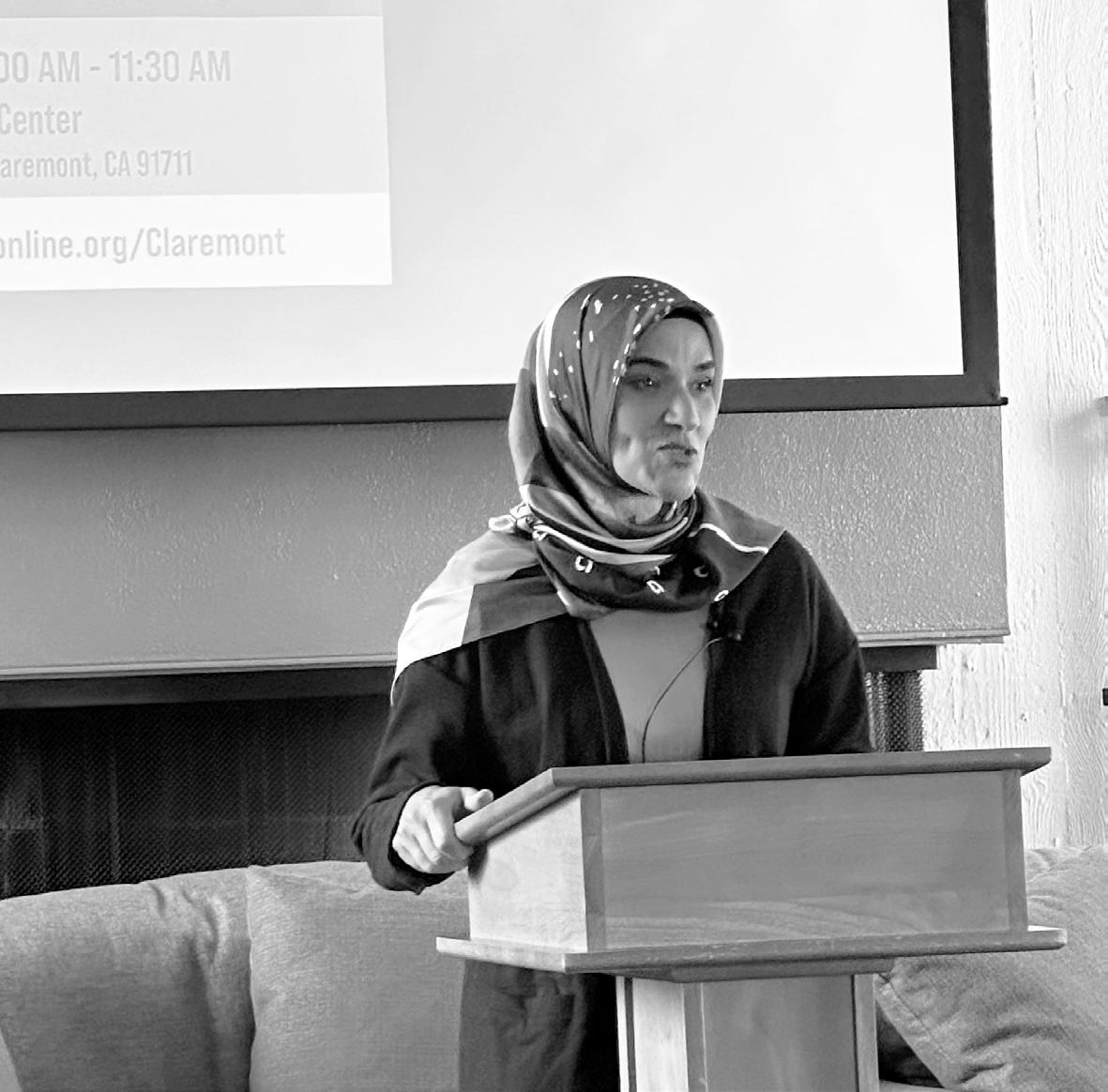
Sexual Assault Campus Climate: A summary of student demographics
SAGE HARPER & JULIA PARSA
On Jan. 24, students at the 5Cs received an email from their respective college presidents announcing the results of the Higher Education Data Sharing (HEDS) Consortium’s 2023 Sexual Assault Campus Climate Survey (SACCS). These results were presented alongside an analysis of the results by the 5C HEDS SACCS working group, which is composed of members from Student Affairs, Title IX, Communications and Institutional Research.
The announcement and analysis of these results follow the survey’s administration last February and they mark continued efforts by the colleges to more fully understand and address issues of sexual assault on campus.
Anonymous and voluntary, the survey was initially designed by HEDS and was created with the purpose of exploring student perceptions of a series of things relating to sexual violence including: the climate regarding unwanted sexual contact and assault, institutional responses, experiences with interpersonal violence and the frequency of a such incidents.
The SACCS administered at the 5Cs last February gathered responses from 17 percent of 5C students, according to the Jan. 24 email. With this in mind, head of Scripps Advocates Cecilia Blum SC ’24 cautioned community members in their use of the results.
“It’s still a very low percentage of respondents, so I wouldn’t encourage people to generalize about the 5Cs based on these survey results,” Blum said.
As stated in the Jan. 24 email, the Claremont Colleges have made large strides since then to make students feel safer. A full list of the changes made since the administration of the last SACCS survey in 2018 can be found in the Actions Taken report that was included in the email.
The report states that the Claremont Colleges hired administrators and investigators to oversee policies regarding Title IX, a comprehensive federal law that prohibits sex-based discrimination in educational spaces
receiving federal funding.
The 7Cs also adopted a new Sexual Harassment Policy (TCC Title IX Policy). The policy prohibits sexual harassment, sexual assault, dating and domestic violence, stalking and retaliation.
In addition, the Claremont Colleges began a collaboration with the EmPOWER Center and Lavender Healing Collective, a group of trauma-trained therapists who provide student survivors with free easy access to unlimited counseling sessions.
Blum reflected on the importance of educating first-year students on sexual assault prevention and support early on in their college careers. This year, 62 percent of respondents to the SACCS who reported being assaulted at the 5Cs stated that the assault occurred during their first year at college.
“We try to educate first-years, but it can be difficult just because there’s also so much other education and stuff that has to go on during orientation week,” she said. “I also think there’s only so much you can teach people when they sit in an auditorium that’s actually going to be useful and applicable as they find themselves in parties or other situations.”
In recent years, Scripps Advocates and similar 5C groups devoting to combatting sexual violence have been working with the Title IX Coordinators and the Empower Center to create a safer,
more connected community on campus.
Still, Emmy Knapp PZ ’26, the newly appointed Liaison to Pitzer College’s Title IX Office, feels that more must be done to combat sexual assault levels on campus. She found that, while many resources exist across the 5Cs, there is a disconnect between these organizations and the students that they serve.
“I know resources available to students because I was a person who was willing to go ask and find them and talk to people and do something,” Knapp said. “That’s not the case for everyone.”
She suggested that Pitzer not only be a place that has resources available, but also one that advertises them well enough for students to take advantage of them. She expressed her hope that roles such as her own one, which was created during the 2023 fall semester, will help close the knowledge and communication gap between the student body and administration.
This goal was similarly expressed in the Jan. 24 email, in which the 5C presidents stated that the SACCS results would help administration more fully understand and address student concerns.
“Because of your participation, we have gained invaluable information that will help us strengthen our community and make it safer for everyone,” they wrote.
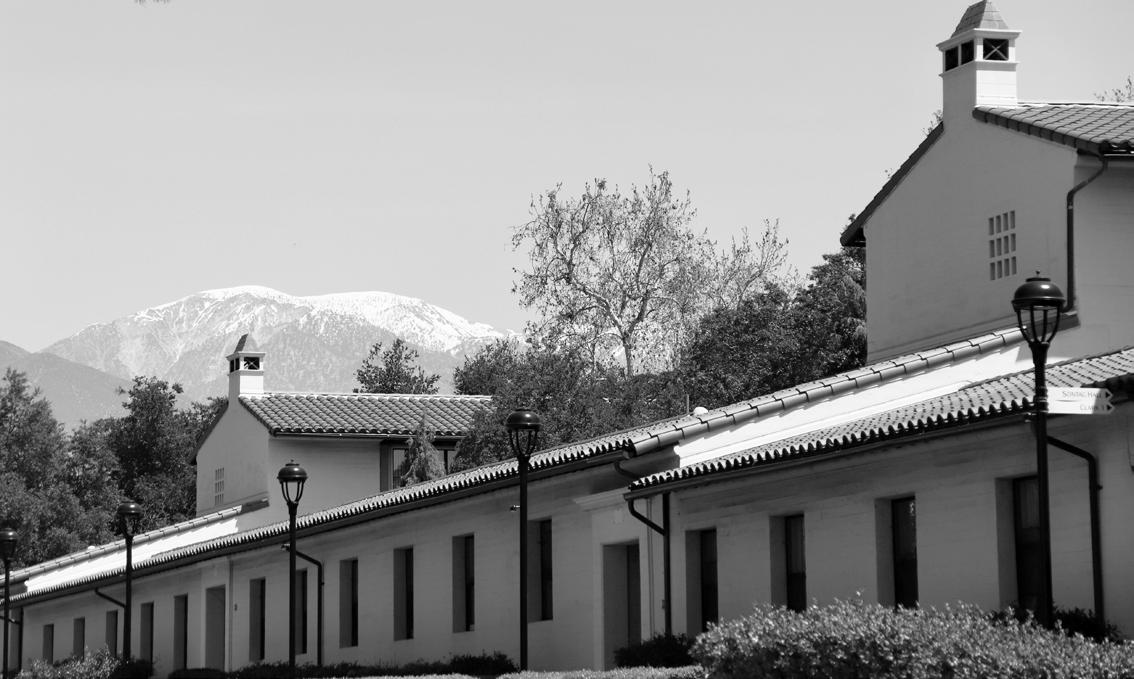
safe, less free and as it grows, it fuels other types of bigotry,” Mogahed said. “The dehumanization of the people of Gaza and of Palestinians is fueling Islamophobia at home, where a six year old child was stabbed by his own landlord 26 times and where three young men no older than my children were shot, because they were speaking Arabic and wearing keffiyehs.”
Mogahed urged audience members to stand against Islamophobia by becoming critical consumers of media and political rhetoric and by recognizing common stereotypes of Muslim individuals. She went on to provide examples of some of these stereotypes.
“[The stereotypes are that] Muslims are more violent than other people; Muslims are more misogynistic than other people; Muslims are barbaric; Muslims are inherently hostile toward America; And the fifth is they are collectively guilty,” Mogahed said. “These are the five key tropes that when people endorse them, when people promote them, they produce bad things for democracy as a whole.”
According to Mogahed, another way to combat Islamophobia is through religious literacy. She explained that this can equip people with information they wouldn’t otherwise know, allowing them to go and spread this information and educate others.
“If I know about the faith that is being demonized and blamed, I’m not gonna fall for that propaganda,” Mogahed said. Audience member Noon El Mosalami PO ’24 said that while the talk brought up some interesting points, there is still more that needs to be discussed when it comes to Islamophobia.
“Mogahed talked a lot about anti-Muslim racism and its rise and its roots, like settler colonial era Europe and the ways that a lot of people continue to be marginalized by the U.S., by these systems that perpetuate harm,” El Mosalami said. “But we also need to discuss a lot more about how we even got here, the kind of trajectories that we want to get towards and what it is that U.S. imperialism really means, what is it to represent so much of our [Islamic] culture backwards.”
SARSOUR: Discussion on Palestinian Liberation
Continued from page 1
She’s also the cofounder of both MPower Change, the first Muslim online organizing platform and Until Freedom, a non-profit organization focused on addressing systematic and racial injustice. From the beginning of the discussion, Sarsour honed in on the importance of having difficult conversations. She said that to her, college is a time to engage, not detach, from the issues you are passionate about.
“Sometimes, parents say that they sent you to university to get your degree and go home — I reject that,” Sarsour said. “My issue here isn’t about whether you think Palestinian liberation is a fight worth having, the question is whether you agree that, on a college campus, students should be able to organize about the issues that they’re passionate about.”
Sarsour emphasized how although advances in technology have increased the visibility of violence against Palestinians for the world, that being faced with constant images and videos of Palestinian death and the destruction of Gaza can take a severe toll on mental health. Nevertheless, she continued to stress the necessity of having these difficult conversations. “We gotta just be normal people and just do normal things,” Sarsour said. “And we’re watching the bloodshed of our people and then on top of that, we have got to fight our administrations to do even an event like this one.”
Identifying the influence students hold on campus, Sarsour continued to encourage students to use their power and position to take action and continue the call for divestment. She highlighted the importance of students taking a stand in spite of pushback from administration.
“This idea that the administration is more powerful than you is already a facade that [the administration] has taught you,” Sarsour said. “There would be no Pomona College without the 1,700 students. The administration works for you.”
Sarsour wrapped up the conversation with another call to action. She encouraged the audience to imagine themselves in the future, looking back at this time with the ability to say that they had organized, participated, voted and “[done] whatever I could with whatever I had.”
This sentiment, along with many others, resonated with students in the audience.
Dabira Alonge-Oludaye PO ’26 expressed her eagerness to do more for the movement toward Palestinian liberation.
“Everywhere I can get educated and just learn more about what’s happening, I’m always available, always eager,” Alonge-Oludaye said.
Gabriel Dalton PO ’24, a member of PSU, also expressed appreciation for the event, specifically praising Sarsour’s candidness with the audience.
“I really appreciated the way she navigated the [audience’s] questions,” Dalton said, pointing out that Sarsour often refrained from outright telling students what to do, instead leaving them to decide. “I really appreciated that sentiment.”
During Sarsour’s final moments on stage, she briefed the audience on two legal cases which went to trial last Friday: the Genocide Case South Africa brought against Israel in the ICJ and a suit against President Biden in the Federal District Court of Northern California in which Palestinian Americans sought to halt funding to Israel.
Finally, Sarsour concluded with a message of hope and resilience in the face of adversity.
“I hope that one thing that you got here today in this room with me is to walk out on this college campus with your back straight and your head held high,” Sarsour said. “That you can feel that you should be unapologetic about who you are and what you represent.”
FebRuARY 2, 2024 PAGe 3 News
Jan. 26,
On
the
Muslim Chaplaincy at the Claremont Colleges collaborated with the bayan Islamic Graduate School to host a conversation with Dalia Mogahed.
COuRTeSY: IMAM HADI QAZWINI, MuSLIM INTeRFAITH CHAPLAIN
eSHA CHAMPSI • THe STuDeNT LIFe On Jan. 24, students received an email from their college presidents announcing the results of the 2023 Sexual Assault Campus Climate Survey.
Check and chat:
Claremont Chess Club tournament creates community
DYLAN ZULUETA
Under a cloudless blue sky, 5C students faced off over roll-up vinyl chess boards in Pomona College’s Clark I Courtyard for the Claremont Chess Club Tournament. Some players stared at their boards in quiet contemplation while others chatted. Electronic club music (“Rumble” by Skrillex) and familiar hits (“Shut Up and Dance” by Walk the Moon) played in the background.
The tournament, held on Jan. 26, marked the Claremont Chess Club’s first tournament in four years, following the club’s reestablishment in 2022.
Eleonore Viatte PO ’24, one of the organizers of the event, compared the atmosphere to scenes from her hometown.
“I grew up in Paris and this is a very classic summer scene,” Viatte said. “In every municipal garden in Paris, there’s a bunch of people. It’s a very specific mood. They play chess in the sun and I think this kind of emulates that.”
The event was the culmination of a collaboration between the club’s presidents and the Pomona North Campus resident advisors (RAs), co-President Kabir Kothari PO ’24 explained.
“The chess club has been running, I think, for the last two or three years and there haven’t been any official tournaments,” Kothari said. “I think people have tried, but logistically, it’s just never worked out. By working with the RAs, it was a bit easier to manage.”
For the North Campus RAs, the event served as an opportunity to create community for their residents.
Sonam Rikha PO ’24, an RA for Clark I, was one of the organizers of the event.
“As RAs, we thought that it would be good to collaborate with the club, because it could increase engagement and turnout as well.” Rikha said. “Because we will get a lot of people from the chess club and then we’ll also get a lot of our own residents.”
In addition to Pomona students, it was important to organizers to open the tournament to 5C players of all chess backgrounds.
“I think a lot of people, when they hear about a chess tournament in college, will be really intimidated,” Kothari said. “I think people in general get very intimidated by chess. So seeing that it’s accessible to all levels, and also splitting it into a beginner intermediate bracket where we’re allowing people to classify themselves,
just makes it more accessible.”
Indeed, efforts from both tournament organizers and participants to create a welcoming environment were on full display. As students walked through the courtyard on their way to their dorms or classes, the RAs beckoned them to join. Players were also encouraged to ask each other to clarify game rules or advice.
Many participants, like Carlos Sanchez PO ’24 had learned to play chess when they were young but hadn’t found an opportunity to play in a long time.
“We have a little chessboard at home, but, honestly, we barely touch it,” said Sanchez. “In my first game, I was still trying to remember which pieces move which way, but it’s been fun.”
A running theme among all the players, regardless of their level of experience, was the tournament’s role as a reprieve from school and other stressors.
Arjun Sisoda PO ’24 has been playing for one and a half years and signed up for the tournament to evaluate his progress.
“I find [chess] quite stress-relieving,” Sisoda said. “Sometimes, I just listen to music and play chess and it’s a good way for me to settle down after a long day. I also like that while it’s fun, it also keeps your mind active.”
Ana Yanez PO ’24, who won the beginner bracket, was especially appreciative of the community that the RAs and chess club created around the board.
“There were people from other schools there, too, and people from other years,” Yanez said. “I got to meet people that I never would have met if I hadn’t just played a game of chess with them. Everyone was really friendly.”
Tendai Nyamuronda CM ’26, the winner of the intermediate/ advanced bracket, learned chess in primary school in order to play with his friends, and he went on to play at the national level in Zimbabwe. He continues to play chess to connect with new friends.
“It’s a way that I can unwind and just be who I am,” Nyamuronda said. “The thing that is most beautiful about chess … once you sit across the table from someone, whether you win or you lose, you have the opportunity to talk to that person and then you can get to know them better.”
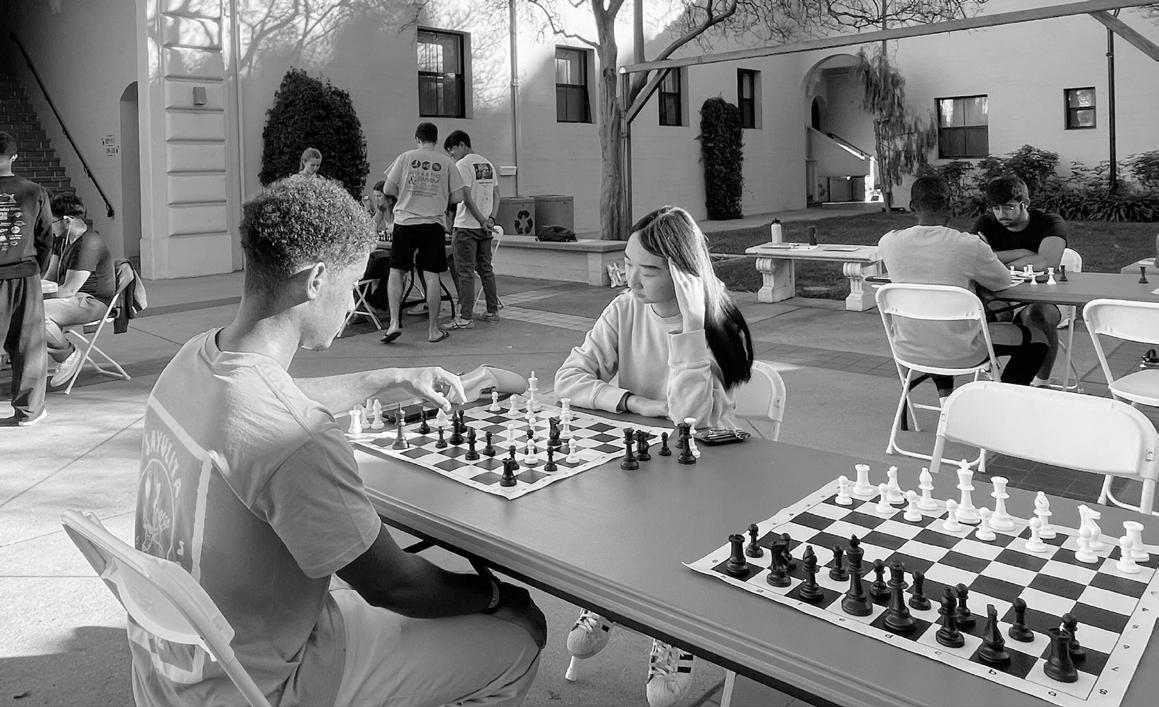
Claremont Village study spots

Here’s the situation: It’s Hump Day, you’re swamped with work and you need a pick-me-up. Or maybe you’ve exhausted your usual on-campus study spot.
Maybe you’re just looking for a change of pace. Now imagine this: You’re sitting in a brightly-lit cafe, a cup of coffee on your left and your pile of work on your right.
Most importantly, all your devices are connected to stable Wi-Fi. Conversations with friends have made me realize that many of us don’t know the area outside the Claremont campuses that well. The Claremont Village is pretty small, and it can feel like you’ve already seen and done everything possible — but there are some hidden gems!
Studying is tough. Maybe you’ve been waiting for someone to tell you this. You deserve to treat yourself for your hard work (maybe with a boba tea or a hot cappuccino) and to give yourself a sugary pat on the back. Here are three cafes in the Village that I recommend checking out for your next study session.
Norema: 313 N Yale Ave
This little cafe, tucked between two clothing stores, is a comforting sanctuary. I first visited Norema with my friends on a sticky summer day during our first week of college. It acted as a relieving salve to the chaos of orientation and jam-packed schedules. Since then, I’ve returned multiple times. The owner is so sweet and accommodating and it’s the perfect space to just sit and get through a particularly stressful workload.
Ambience: ⅘ I love Norema’s ambience; the soft jazz music playing in
the background provides a perfect soundtrack for studying. It’s reasonable for group work but can get a little crowded during peak hours.
Affordability: ⅘ (drinks: $4-6, food: $7-10)
Be sure to ask for a stamp card if you think you’ll be a returning customer: You can get one free drink per six drink purchases.
Overall Study-ability: 4.5/5
What to Order: Although the Thai Tea is a fan favorite and all of the drinks are super refreshing on a hot day (the menu’s choose-yourown-adventure style encourages you to try out different combinations), I’m the biggest fan of Norema’s food, which remind me of my favorite homestyle Chinese restaurants back home. If you tend to get hangry during long study sessions, try the pan-fried dumplings (pork or chicken) or piping-hot soup dumplings.
Iron & Kin: 536 W 1st St
Ambience: 4.5/5 Iron & Kin’s interior is super trendy, well-lit and has good feng shui – this is the perfect place to lock in and get some work done. The only downside is that it can get busy and it’s difficult to find an open table, especially on weekends. The long line to order, which tends to snake out of the door, can be a little distracting.
Affordability: ⅗ (drinks: $4-$6.25) This cafe definitely skews on the pricier side of Claremont’s cafe offerings, but I find that the quality is worth it: The baristas are super friendly and the drinks are consistently good.
Overall Study-ability: 4/5 What to Order: I’ve only ever ordered their matcha (yes, I’m one
of those cafe lovers who doesn’t actually enjoy coffee; my go-to item is always an iced matcha), but it never disappoints.
CK Cafe: 109 Yale Ave
When you think of hole-in-thewall, this is pretty much exactly what comes to mind. Specializing in tea, this cafe embodies this concept; the entrance off Yale Avenue is hidden in the corner of Alley 39’s narrow parking lot. However, its shocking (and perhaps overwhelming) list of drinks ensures that everyone finds something they like.
Ambience: ⅗
My friends and I were at first a little hesitant when visiting this cafe. Besides the fact that it’s super hard to find the entrance, the one-room shop is dimly lit and there’s a lingering scent of cigarette smoke wafting in from the outdoor patio. However, the tables are great for group work, the couches are comfortable and the Wi-Fi is stable! It’s easy to feel like you’ve left Claremont for a while, as the space feels so vastly different from all the other quaint shops in the Village.
Affordability: 5/5 (drinks: $2.25-$5)
Choosing what you want to get from the seemingly endless offerings, which are scrawled on and around the walls, is the most difficult part of the process. The prices are really reasonable.
Overall Study-ability: 3.5/5
What to Order: You likely can’t go wrong with any of their drinks. However, they’re best known for their blooming flower teas, which are both photogenic and flavorful.
Small business columnist Michelle Zhang PO ‘27 ranks her top study spots in the Claremont Village by ambience, affordability and overall study-ability.
Art beyond trauma: 79th Ceramic Annual exhibition reshapes narratives of brownness
Lively conversation reverberated through the walls of the Ruth Chandler Williamson Gallery at Scripps College as visitrs experimented with digitized ceramic experiences, interacted with performance art and engaged with sculptures and floor-to-ceiling paintings.
The 79th Ceramic Annual opened to the public on the evening of Jan. 27 with the theme “The Idea of Feeling Brown.” Curator Jasmine Baetz, Scripps’ Lincoln visiting artist in ceramics, organized the show around the central theme of brownness as community and resistance, drawing inspiration from the work of queer performance artist José Esteban Muñoz.
In the exhibition’s catalog, artist Kristie Soares explains that each artist formulated personal responses to Muñoz’s concept of brownness as far more than just a phenotypic marker.
True to Muñoz’s expansive vision, the pieces in this exhibition incorporate a variety of art forms, such as augmented reality (AR), oxidized paintings and performance, to embody the ways that brownness “walks, breathes [and] fights in a world organized by and for whiteness and in an art realm that often replicates these power dynamics.”
Upon entering the gallery, Magdolene Dykstra’s vast, floor-toceiling finger painting catches the eye in both form and scale. Using soil, clay and naturally occurring oxides, Dykstra’s work uses indigenous cave paintings to transform
the white gallery walls into a mirage of color, asserting the right for her brownness to take space within historically exclusionary institutions. Each artist’s mediums and presentations differ greatly from one another, yet stand united in their central theme of conceiving of brownness beyond trauma. Television screens scattered around the room display content from intergenerational interviews with Indo-Caribbean families to a performance art piece depicting a woman sculpting with her teeth.
Attendee Daniella Zepeda SC ’27 expressed how the work subverted her conceptions of what a ceramics show entails.
“When we think about ceramics … it inherently has to do with your body,” Zepeda said. “Watching the video of [contributing artist Raheleh Filsoofi] creating ‘BITE,’ actually making patterns with your teeth and tasting it, it visualizes this sensory, all-encompassing feeling that ceramics gives you.”
Contributing artist Habiba ElSayed described how ideas from both Egyptian mythology and ’90s childhood nostalgia inspired her two pieces for the exhibit: a combination of clay sculpting and AR interaction titled “Ba-bie Soul House” and a virtual reality experience titled “Unstolen.”
Drawing on elements of her cultural background as a Guyanese-Egyptian Canadian, ElSayed spoke about how these pieces fit into her journey as an artist as she works to move beyond narratives of brownness
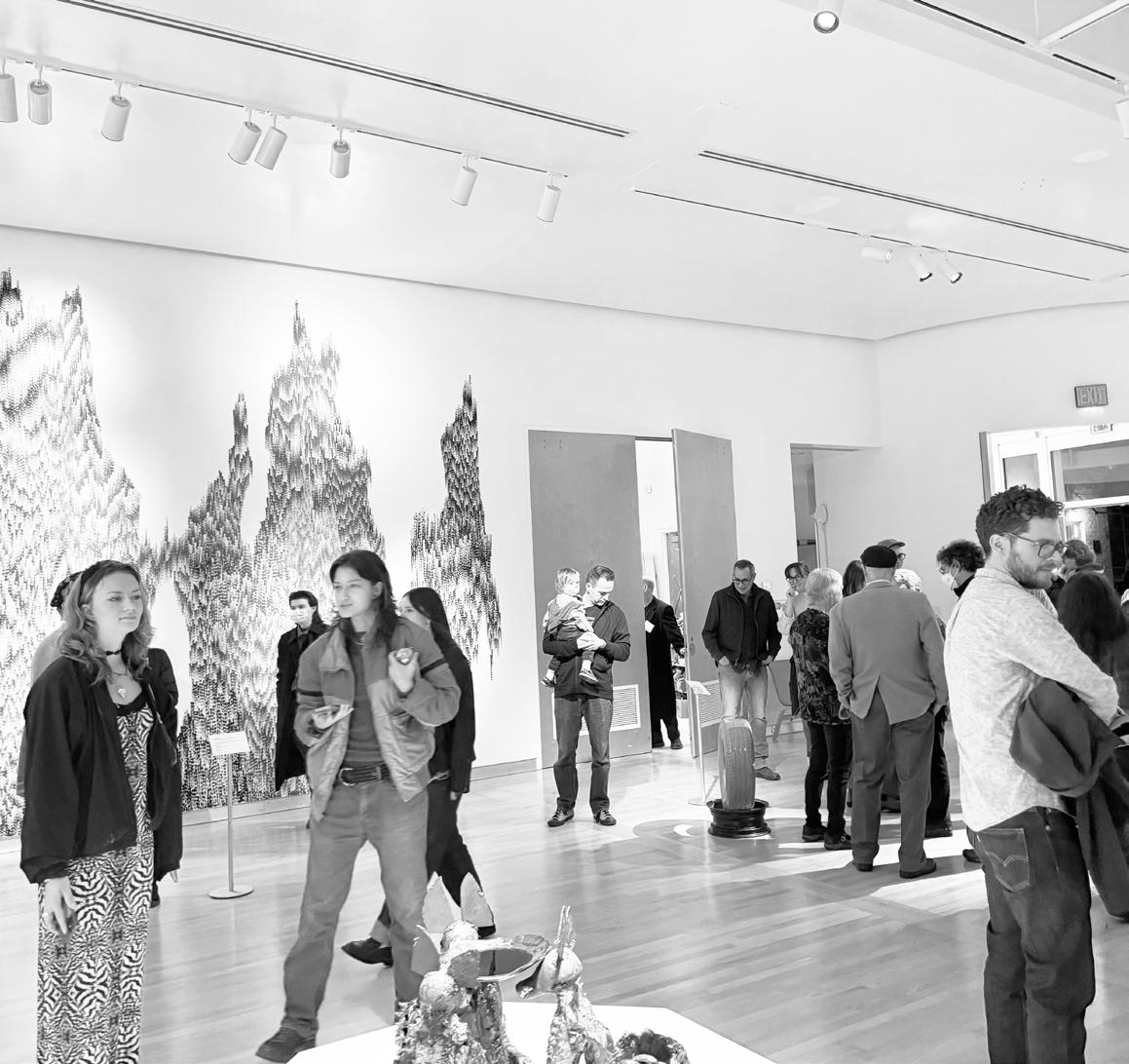
centered around trauma and violence.
“Beyond all the ethical parts, it just gets boring,” El-Sayed said. “I don’t think any of us want to keep creating trauma all the time — we have other parts of us that we want to be exploring in our work.”
Despite grassroots movements to expand the range and visibility of BIPOC individuals in the art world, she explained, the field of ceramics remains dominated by white curators whose shows often exude elements of saviorism and
tokenization. “Exploring my identity through clay, performance and digital means allows me to exist within these spaces and institutions, not trying to fit in but rather intervening and interjecting within them,” El-Sayed said. Across the gallery from ElSayed’s work, Trinidadian artist Heidi McKenzie presents a series of images of women, each smiling fiercely as they hold a photo of another Indo-Caribbean woman they admire. Illuminated from behind, these photographs cast a
warm light across the floor as joy emanates from the women’s faces.
McKenzie holds space for these women by showcasing their joy as they proudly display their heritage in a way that moves past trauma.
“Brownness,” immigration and otherness are not inherently traumatic concepts, McKenzie’s work asserts, but instead identities that hold the weight and warmth of a community united in joy.
Drawing parallels between predominant narratives of brownness and the field of ceramics, McKenzie described how rigidness within the definition of “ceramics” mirrors identity policing.
“I’m not interested in other hierarchies and supremacies,” Baetz said. “I’m not very interested in the tightly gatekept ceramics universe that’s limited to a particular way of understanding the material or process.”
As part of their collaborative zine, the students in Baetz’s class “Special Topics in Ceramics: Feeling Brown” read Muñoz’s “The Sense of Brown” and created ceramic sculptures that explored each person’s “individual, different and yet connected ideas around ‘feeling brown.’”
The published zine is available for free at the Williamson Gallery.
“Insofar as I’m affiliated with an institution, I’m always going to use that space to enact the kind of art and future that I think we should all have together,” Baetz said.
The 79th Scripps College Ceramic Annual: The Idea of Feeling Brown is open Wednesday through Sunday from 12 to 4 p.m. through April 7, 2024.
PAGE 4 FEbruAry 2, 2024
&
Arts
Culture
DyLAN ZuLuETA • THE STuDENT LIFE
CLAIrE WELCH • THE STuDENT LIFE
MAX rANNEy • THE STuDENT LIFE
CLAIRE WELCH
LET’S GO LOCAL
MICHELLE ZHANG
Students playing chess at Pomona Chess Club tournament.
The 79th Ceramic Annual opened on Jan. 27 at Scripps College’s ruth Chandler Williamson Gallery
Holy sincerity! How “Batman” (1966) stands up to the self-conscious super-genre
GERRIT PUNT
I’m tired of self-awareness. I’m tired of irony and cynicism and observational quips and the truth is, I don’t know how much more of that I have in me.
It feels so ingrained at this point. It’s like a commandment: Thy movie characters must be clever and snarky and speak like Joss Whedon. It seems to be basically everywhere and to some extent it is, but if there’s any one thing that this style of writing is associated with, it’s superheroes.
It feels a little bad to start the new year with yet another MCU thinkpiece, but they’ve brought this on themselves. For my own sake I’m going to try and focus the bulk of my attention on a superhero film that actually brings me some joy — 1966’s “Batman,” a brilliant little action-comedy whose positive qualities collaterally undermine most super-movies of the new millennium.
“Batman” follows spandex-clad do-gooders Batman and Robin as they attempt to thwart a villainous plot to kidnap a brewery tycoon, commandeer his dehydration gun and turn the leaders of the world into little piles of dust. Simple stuff.
Batman carries a big black spherical bomb above his head. Batman is saved by a rogue porpoise. Batman obliterates a man with antimatter. It’s a story spanning Cold War tensions and pirate henchmen and shark repellent bat-spray and it’s wonderful.
It’s convoluted and slipshod, but
in a landscape of superhero films polished well past the point of being interesting, there’s something remarkably refreshing about it. Its unabashed silliness and raw confidence have aged it beautifully, like a fine Bat-Merlot.
Superheroes and comedy have always sort of gone hand in hand. There’s an inherent humor to the superhero — the capes, the brazen vigilantism, it’s all a little silly. That’s certainly not a bad thing, but it’s something writers have to reckon with.
Most choose to confront the genre’s intrinsic absurdity headon, beating the audience’s potential judgment to the punch with carefully timed wisecracks and sarcastic, surface-level examinations. It’s a style of writing that lends itself to characters on screen acting as mutual observers with the audience, snarking about the silliness of other heroes’ costumes and the grandiosity of supervillain plans for world domination. Frankly, it’s well past tired.
In their attempts to be selfaware, a litany of films have only really succeeded in making themselves self-conscious — too embarrassed by their own premises to commit to much more than winks and nudges and perpetually concerned with assuring viewers, “don’t worry, this is all a big joke.”
These critiques are most heavily leveraged against Marvel, but once you start looking for this type of writing you start to see it everywhere. They didn’t invent this, nor are they the only ones doing
it. They’re merely pioneers — akin to the poor folks that trudged their way across the Oregon Trail, but poisoned by irony instead of dysentery.
Because really, what’s wrong with letting things be silly? What’s so wrong with earnesty? For brands so committed to selling impossible characters with outlandish names and costumes, it all reeks of embarrassment and an unwillingness to admit that on some level, superheroes are a little dorky.
“Batman” does something much more difficult and arguably much braver: It plays it all straight, at least as much as it can. It understands the inanity of a bat-themed vigilante and his boy ward and,
instead of getting embarrassed about it, it leans in. The fact of the matter is that Batman and Robin aren’t that cool. They’re strict abiders of the law who wield hyper-specialized bat-gadgets and spout PSAs on the importance of respecting police and not letting people get blown up by bombs, even if they’re alcoholics. (“They may be drinkers, Robin, but they’re also human beings.”)
It’s ludicrous and it’s silly and the hard truth is that being silly requires a level of confidence that most filmmakers just don’t have. “Batman” works as a comedy because it isn’t afraid to be laughed at. That isn’t a jab at it. It’s commendation.
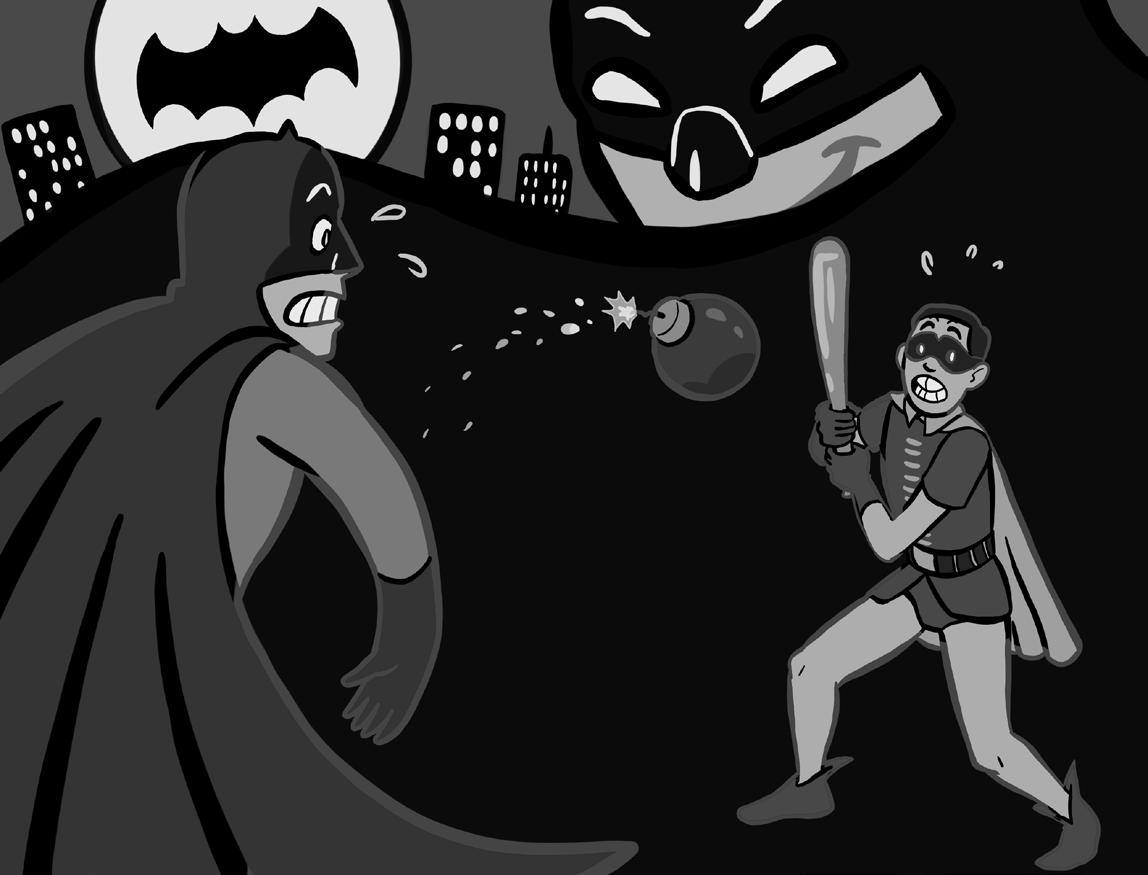
Freedom in fashion: CMC goes international

With over 100 Claremont McKenna College (CMC) juniors returning to campus from study abroad programs across the world, CMC’s campus not only feels like it is flooded with familiar faces, but also with totally new and exciting attire. It appears that my prayers have been answered as my peers have finally realized: Pajamas, sweatpants and leggings are not acceptable fashion choices anywhere outside of the United States.
As an international student from Europe, I have always wondered about how university students back home would react if they saw a typical CMCer strolling into their lecture, fitted up with the infamous Claremont-Mudd-Scripps shirt, flipflops and gray sweatpants. My guess is that they would be flabbergasted and appalled and they wouldn’t hold back from sharing that opinion with you.
But to truly find out the attitudes of students and locals abroad towards American students’ fashion, I investigated the experiences of five CMC juniors who studied abroad in Argentina, the Czech Republic, Spain, Portugal and Tunisia. Hopefully, their shared, newfound wisdom will inspire CMC students across all years to ditch the pajamas and put on some real pants.
According to Jack Barrett CM ’25, during his pre-departure packing, “Fashion was kind of a secondary thought.”
Students like Henry Fina CM ’25 took a practical approach, carrying a “playing it safe” attitude.
“I wanted plain clothing that wouldn’t stand out in the crowd and make me a target,” Fina said. “I was very concerned about that.”
Upon arrival in Seville, Spain, Pierce Sanderson CM ’25 realized that he’d be needing to step it up.
“You feel like you need to dress to match the expectations and if not, you’re kind of getting some
dirty looks,” Sanderson said. “In my opinion, this is not necessarily a negative practice and it may benefit CMC’s fashion culture, or lack thereof.”
Meanwhile, Talia de Beer CM ’25 had some more positive reflections to share.
“What I’ve noticed about Europe is that people dress like their cities,” de Beer said. “So when it comes to color palettes, I think that people very much dress in the same color palette as their cities. And I was able to pick up on this so I made sure that my pieces incorporated some patterns and colors to match the city.” Our CMCers’ main fashion takeaways from their semesters abroad?
“It was a positive change,” Fina said. “I think I just got more comfortable with having pants on versus shorts and sweatpants.”
One more convert added to the list.
Additionally, de Beer noted the lack of judgment during her time abroad.
“I did think that it would be a fun experience to try new things with my fashion sense because I wouldn’t feel judged or pressured to dress a certain way when I was in Lisbon,” de Beer said. “And it really gave me creative freedom so I could try things that I probably wouldn’t have been wearing on campus.”
However, some CMC men still returned with their passionate obsession for sweatpants.
“They’re better to wear than a pair of slacks,” Fina said. “Especially if you’re going to work in an office, you hate your life, you have a wife and kids that you don’t really care about because you work so often so you never get to see them, it becomes a sore subject. And you just got to enjoy the little moments like putting on a pair of sweatpants and going to Walmart.”
Sanderson had a question for Fina.
“Have you ever worn a sweatshirt and no shirt and sweatpants and no underwear?” he said. “That is freedom,” Fina replied. “And I think that one of the seminal American values is freedom and we dress to reflect that.”
One of de Beer’s favorite takeaways from abroad is one that I recommend all 5C students adopt.
“I think that I was very confused in my fashion sense when I first arrived at Claremont and going abroad and collecting new pieces has made me really excited to wake up in the morning and plan my outfit,” said de Beer. “I hope that sticks.”
George Ashford CM ’25, who studied in Tunisia, reflected on the wardrobe change.
“I felt lucky to be able to afford new clothes,” Ashford said. “That’s a big one, because pretty much all the clothes there are secondhand. I think that’s why some of the stuff felt a little behind trend, just because people can’t afford to buy new clothes, especially from American brands.”
Looking for a positive outtake on CMC fashion? Fina has you covered.
“Dress how you want to dress,” Fina said. “I think it’s one of the best aspects of our campus — you’ll see people wearing whatever. Some people dress like they’re about to go to a job interview, or like they’re about to step into an investment banking office. Some people are dressed like they just got out of the gym and there’s nothing wrong with that.”
Elizaveta (Lisa) Gorelik CM ’25 is from Moscow, Russia. After spending Winter break at home, she feels very relieved to be wearing sweatpants again.
When the caped crusader calls up his old comrade the Admiral (hard at work playing tiddlywinks with his secretary), he is informed of a surplus naval submarine sold to a Mr. “P. N. Gwynne” — a pseudonym Robin brilliantly deduces must belong to the Penguin.
It’s not a mind-blowing joke by any means. It’s not even really very funny but, after a lifetime of characters incapable of taking anything seriously, watching Batman and his weird little sidekick hear such a flagrantly awful stage name and abstain from quippery felt like a cool bat-breeze on a hot bat-day.
We’re living through an era where 10 superhero films can come out in a single year and somehow none of them seem to possess even a shred of camp. I ask, then, what’s the point? Where’s the fun in watching bulging men in capes if all the bulging men in capes have to be so … above it all?
I’ve been optimistically calling 2024 the year of earnestness. That’s founded on basically nothing, but with how tired of superheroes everyone seems to be getting, there might be a glimmer of truth to it. Last year gave us “Barbie” and “Bottoms,” two films that are basically nothing like “Batman” but at least show that there’s still some collective interest in letting things be campy once in a while.
In the meantime, “Batman” (1966) isn’t going anywhere.
Gerrit Punt PO ’24 has been shopping around his own superhero “Arts & Culture Man” for a while now. So far no studios have taken him up on it.
A love letter to Malott breakfast
Returning to campus for spring semester feels different this time around. Two of my dear friends are studying abroad (Natalia Huizar SC ’25 and Eliana Meza-Ehlert PZ ’25), my class schedule is the most peculiar it’s ever been (I only have class Monday through Wednesday, but on Mondays I end class at 10 p.m.) and, as with every semester, I’m acclimating myself to a new routine.
I’m doing my best to embrace the changes, celebrating the return of the fall ’23 study abroaders and opening myself up to the possibility that perhaps my evening Dream Lore class will shed some insight into my own dreams, but these changes are also making me all the more grateful for the small things I’m able to carry over from one semester to the next. Malott breakfast, in particular, has been a constant in my college experience. I’ve eaten Malott breakfast on a regular basis ever since my sophomore fall, which also means that yes, I consistently made the trek up to Scripps College even when I lived all the way on Pomona College’s South Campus. I never minded the walk because I’m a naturally early riser. I actually appreciated the way it forced me to get some steps first thing in the morning. I also loved seeing people from the neighborhood taking their dogs on a leisurely walk throughout campus. Now that I live on Pomona’s North Campus, the walk takes me half as long, but I am still thankful for the way this act of going to Malott breakfast gets me swiftly out the door and moving each day. As much as I love my bed, the routine of going to breakfast has helped me start my days off right. Each morning I wake up, get ready and am out the door in a flash — after all, Malott breakfast is calling. I also appreciate Malott breakfast because it’s over this meal that — when alone — I’m able to get a surprising amount of work done. In previous semesters, I would sit in Malott and plow through the densest Phonology and Bilingual Cognition readings that I struggled to comprehend even the night before and this semester I find myself already doing the same with my English readings. For some reason, it is in this dining hall, in the early hours of the morning, that I am able to more lucidly formulate my thoughts on grief versus mel-
ancholia, archetypal formations in dreams, what exactly happened in Act 2 of Christopher Marlowe’s “The Jew of Malta” — and actually put words to a page.
I don’t exactly know if my enhanced productivity and mental clarity is coming from Malott’s cold brew (which I’ve expressed my love for in a previous column), the combination of cold brew in one hand and a smoothie that I’ve been trying out recently in the other, or the quiet ambience of the dining room, where all I can hear is the whirring of the coffee machines and sounds of other early risers click-clacking away on their computers. It’s possible, too, that Malott’s granola is the secret to my success. Quite frankly, I love Malott’s granola. It’s crunchy but not too chunky and I, along with my friend Chloe Chen PO ’27, personally appreciate the fact that it is raisin-free (Chloe is also an avid Malott granola fan!). It’s the perfect topping to a heap of Greek yogurt, or perhaps on a slightly more controversial note (I know that some people have qualms about the texture), my go-to base — cottage cheese.
I eat breakfast on my own most of the time, but on the occasion when other friends join me in the dining hall, I am also grateful for Malott breakfast in how it holds space for sweet conversations as we start our days. Sometimes, when we are all tired from the night before, the conversations are of few words (and instead yawns and subsequent laughter), but that’s okay. Whether we come to breakfast energized and chatty or evidently sleepy, I am grateful for Malott breakfast for providing me opportunities to sit down with my friends in the mornings, check-in briefly and then go about our all-toobusy schedules.
Overall, Malott breakfast has been a much-needed pillar of constancy for me as a brand new semester has begun. I will be honest — though we are entering week four, I feel as if it is week 10 already, and this early-morning meal at Scripps’ lovely dining hall has provided me the stability that I crave amidst the hustle and bustle of classes and clubs and work and social events. I hope that as we settle into this new semester, you can find some source of stability, too. Maybe, one morning, you can join me at Malott. I’ll be by the cold brew and you’ll find me engrossed in my readings.
Emily Kim PO ’25 is from Irvine, California. Her current hyperfixation song is “Bruises Off the Peach” by Ryan Beatty and at the moment she is very tempted to buy Hello Kitty platform crocs.
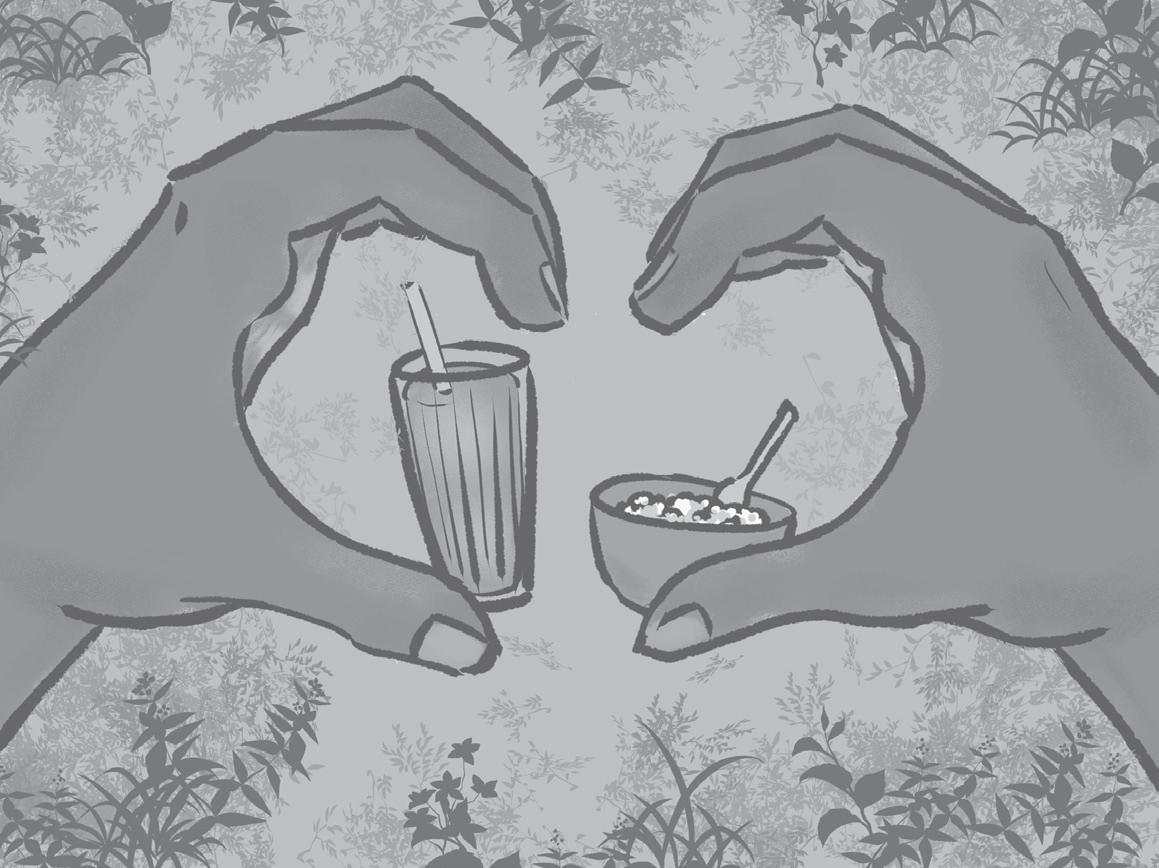
FEbruAry 2, 2024 PAGE 5
&
Arts
Culture
LuCIA MArQuEZ-uPPMAN • THE STuDENT LIFE
SASHA MATTHEWS • THE STuDENT LIFE
EMILY KIM
MOMENTS TO SAVOr
FASHION bIbLE
LISA GORELIK
MAXINE LE • THE STuDENT LIFE
FrAME rATING
Art21 screening: The tangible process of art
ANANYA VINAY
Many non-artists think of artmaking as a solitary endeavor. A recent documentary series by Art21 challenged this sentiment by showcasing the role that community plays in the artistic process.
On Jan. 27, the Benton Museum of Art at Pomona College held a screening of two documentaries by Art21. Founded in 1997, Art21 is a nonprofit organization that aims to expand access to contemporary art through documentaries and public programs.
The two documentaries were “Everyday Icons” and “Bodies of Knowledge” in season 11 of the series “Art in the Twenty-First Century.” Each episode featured four contemporary artists and offered a close look into their artmaking process.
The screening focused specifically on the work of artists Rose B. Simpson and the Guerrilla Girls. Justine Bae Bias, the communications director at the museum, explained to the audience that both featured artists have worked with the Benton in the past.
“It really made an impression on me, and to see both [of] them … in the same season, it was a no-brainer to feature them,” Bias said. “[These episodes are] a wonderful way to see … what goes behind the artwork and how [that elevates] the meaning of the artwork.”
Noor Tamari PO ’22, a former intern at the Benton, works now as an executive assistant at Art21. She introduced the documentaries via Zoom as the audience watched in a casual, intimate environment.
“[COVID-19] gave Art21 a very unique opportunity to examine … how can artists help heal a culture,” Tamari said. “What came out of that [in season 11] was the stories of artists who were making work that was digging into deeper dreams and creating essentially new art forms in the face of cultural identity shock.”
Simpson, the artist featured in “Everyday Icons,” is a mixed-media artist from Santa Clara, New Mexico, who creates work related to stereotyping and nurturing Indigenous culture.
Simpson emphasized the influence of community and In -
digenous heritage on her art, focusing specifically on her relationship with her mother and daughter. Simpson’s mother is the person who first taught her to use clay — a skill she is now passing down to her own daughter.
“There is no separation between art and life … to be able to make work that’s building a conversation together is a beautiful chance to heal,” Simpson said. “Within the indigenous world … we have this big heart to exist and empower ourselves and to change the narrative and express what it means to carry this story forth.”
One of Simpson’s primary projects is a series of both miniature and life-sized clay sculptures of indigenous ancestor figures. She makes her artistic process tangible through visible fingerprints in the clay.
“We’re trying to understand
ourselves and be graceful and compassionate and accepting of all the many things that we all are,” Simpson said in “Everyday Icons.” “I’m trying to reveal our deep truth and that deep truth is [a] process and so why would I hide that process? To show the actual making of something is our power.”
The Guerrilla Girls, featured in “Bodies of Knowledge,” are an anonymous collective of women artist-activists who have been challenging systemic inequalities in the art world since 1985. The interview featured “Frida” and “Kathe” (pseudonyms), two of the founding members of the collective.
Iconic in popular culture for disguising their identities with gorilla masks, their approach to activism consists of sharing statistics about discrimination against women artists and artists of color on posters with
dramatic headlines.
“There’s nothing worse than the word ‘art appreciation.’ It implies that you’re just there awestruck and whatever you’re being fed you appreciate,” Frida said in “Bodies of Knowledge.”
“Art is really about discourse and discussion.”
Kathe reflected on the exclusion of women artists, who are often only recognized after a lifetime of work, if at all.
“From the beginning, we have been fighting against racism, sexism and the death hold that wealthy people and wealthy institutions have on art and culture,” Kathe said. “What artists have to say about [their] art has not always been considered important by the arbiters of the art world.”
Attendee Ananya Goel PO ’24 found that Kathe’s statements about the lack of diversity in the art world did not reflect her ex -
perience as an intern at the Whitney Museum of American Art.
“[The museum was] working so much with modern and contemporary feminist artists that I felt like things were better than I expected,” Goel said. Both episodes ask their audiences to make space for diverse discourse in art, be it in museums and art galleries or the artmaking process.
Attendee
Sula Ferrer, a local artist, was surprised by the degree of artistic innovation present in the documentaries, such as in the work of Daniel Lind-Ramos, who creates vivid sculpture assemblages using objects found on the beaches in Loíza, Puerto Rico.
“The audience [might not be] familiar with how much intention goes into [artmaking],” Ferrer said. “It was really refreshing to see how people can look at items and completely reconceptualize them.”
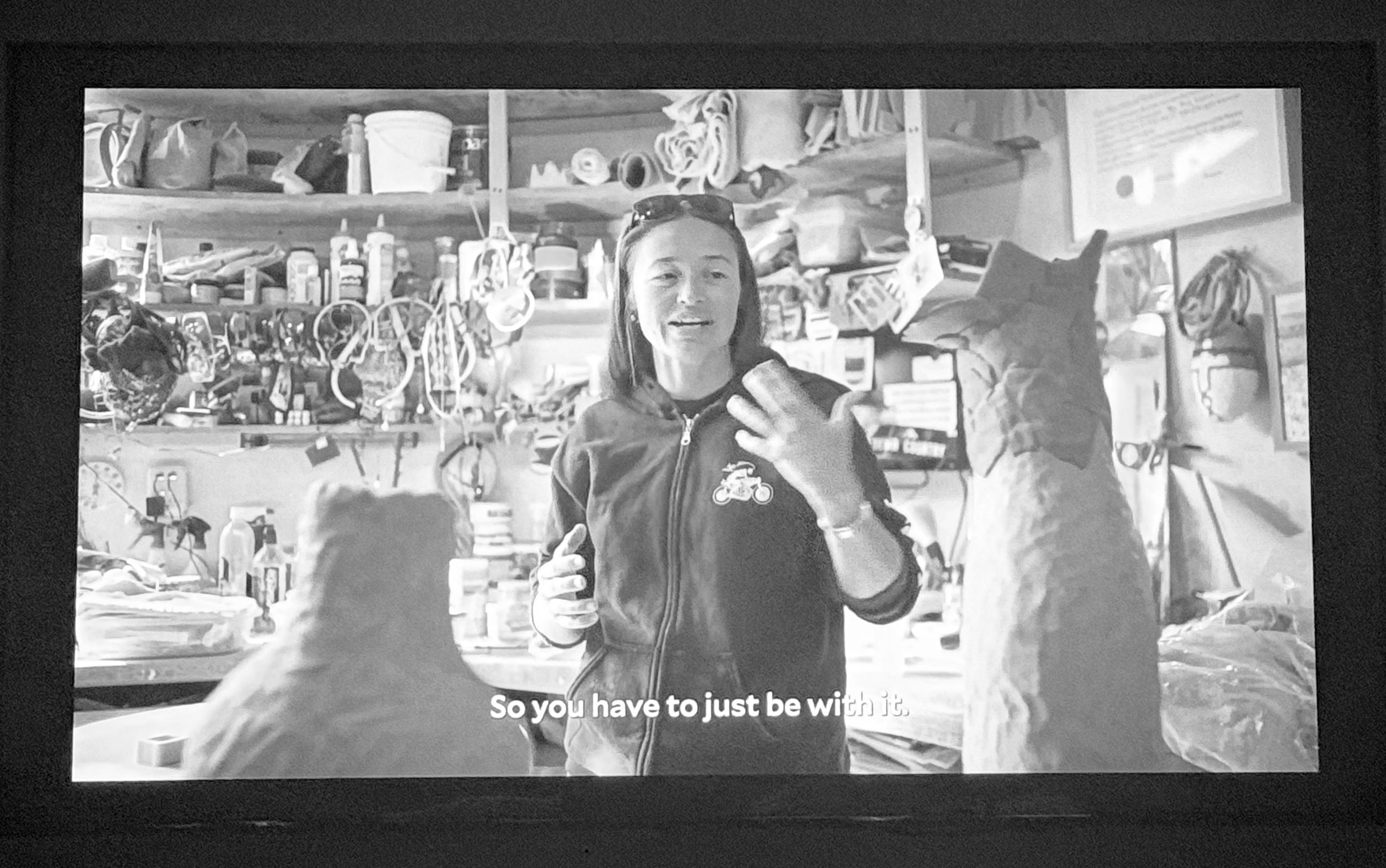
Word wars: Wokeism and the battle over language
ADRIANA MACIEL
According to John McWhorter, people have “prescribed” terms like “Latinx” and “BIPOC” to push social change as part of a recent phenomenon known as linguistic prescriptivism. McWhorter asks: Does this process work? And will these terms remain in public consciousness?
McWhorter, a Columbia University linguistics professor, New York Times columnist and author, spoke at Claremont McKenna College’s Athenaeum on Jan. 26. He argued that linguistic prescriptivism is not effective in changing thought, as it is imposed “in neglect of certain realities about language that can be different to
perceive.”
McWhorter acknowledged that new terms are created in the name of progress. “But prescribing language changes before thought and assumptions in society have moved in that particular direction doesn’t actually [help people],” McWhorter said.
McWhorter first argued that many of these new terms are embraced by a select group of people and not necessarily the group intended. He cited as an example the term “Latinx,” a gender-neutral alternative of “Latino” or “Latina.” McWhorter stated that the problem with this term was that only 3 percent of the Latino population use the term. In the world beyond
academia, it is “considered aesthetically unpleasant” and is an attempt to erase the gendered aspect of a language that has a binary grammar gender system.
McWhorter highlighted the arbitrary nature of linguistic evolution. Some terms make it and others don’t, he said. He stated how the acronym BIPOC,” which centers Black and Indigenous consciousnesses, is also predominantly used in academia and may not gain widespread acceptance in the general public. He quipped that the acronym almost sounds like a “medical condition” or could be mistaken as referring to bisexual people.
Still, McWhorter acknowl -
edged some examples in which new representative words did catch on: In 1989, “African American” started being used “almost overnight” and in 1987 the term “Oriental” fell out and people started to use “Asian.” Despite the good intentions behind all these prescribed terms, these two terms were among the few that gained traction both within their respective communities and nationwide. McWhorter was squarely against the Sapir-Whorf hypothesis, created by linguist Benjamin Lee Whorf and Edward Sapir, which states that language channels thoughts to a large extent. McWhorter contended that language does not shape thought

to the extent that it fundamentally alters the glasses through which individuals view the world.
“You can’t make people think differently by changing the word, or rather the thoughts that are attracted to a particular term at a given time,” McWhorter said. “If you take the term away, those thoughts just fly towards the new term and after a generation, you need a new one.”
McWhorter observed that decades ago, the words “bum” and “tramp” were commonly used, but due to their negative connotations, “the homeless” became preferred. Now, he said, there has been a push for “the unhoused” to replace “the homeless” to shift us away from these negative perceptions. However, McWhorter noted that “the homeless” acquired those same negative connotations over time anyway, a fate which will inevitably befall “the unhoused.”
“Language and meaning don’t walk in the lockstep that we often think that they do,” McWhorter said. “The dictionary definitions of the words do not necessarily match their book definitions.”
McWhorter suggested that we accept the reality that words can slip beyond what their dictionary definitions are. One shouldn’t force others to use these terms because it can do more harm for their cause than good.
McWhorter also noted the incongruence between the dictionary definition of diversity, equity and inclusion (DEI) versus DEI programs implemented today.
“You may be for [DEI], you may be against it … it doesn’t mean that you’re against equity,” McWhorter said. “You’re against what equity means within the confines of how DEI operates within our times.”
Stella Kazanjian SC ’27 appreciated McWhorter’s multifaceted approach to the central issue.
“I thought it was interesting how he connected the two sides,” Kazanjian said. “He gave arguments for each side about the words … iIt wasn’t too one-sided. It incorporated facts [as well as] perspectives.”
McWhorter concluded his talk with advice to the audience in regard to the nature of change and its incompatibility with “‘Whorf-ianism.”’
“The sad thing is that in order to change how people think, you have to change how people think,” McWhorter said. “You have to make arguments … be prepared to get pushback. It is easier to believe change doesn’t happen than to acknowledge it happens slowly.”
PAGE 6 FEbruAry 2, 2024
&
Arts
Culture
ANANyA VINAy • THE STuDENT LIFE
The benton Museum screened two documentaries by Art21 on Jan. 27/
COurTESy: CLArEMONT MCKENNA COLLEGE
John McWhorter was invited to speak at Claremont McKenna College’s Athenaeum on Jan. 26..
Unmasking bias: The human element in algorithmic decision-making
ELLA FRANCIS
Open the message app on your phone and type in the name “Ayaan.” Your phone automatically changes it to “Susan,” the closest white equivalent. Even if it does not immediately change it, the name remains underlined in red: ERROR.
This is a product of machine learning — a form of artificial intelligence (AI). Algorithms like this comb through millions of pieces of data, detecting patterns and making predictions without being told what to look for or what to conclude. The appeal is immense and AI is finding its way into every aspect of our lives, from autocorrect word assumptions to facial recognition software to healthcare decisions.
Despite a common assumption that machines are impartial decision makers, working from cold, hard data, there is an inextricable link between AI and perceptions humans have of the world.
“Algorithms are still made by human beings, and those algorithms are still pegged to basic human assumptions … if you don’t fix the bias, then you are just automating the bias,” famed American author and journalist Ta-Nehisi Coates said at the annual 2019 MLK Now event.
By examining the use of AI in the healthcare industry, it becomes apparent that algorithms perpetuate human biases and are another platform that disadvantages Black people.
AI reinforces supposed Black inferiority, a myth that conveys Black people as physically and genetically inferior.
The “cold, hard” data that shapes algorithms is rooted in a historical context where information and studies have predominantly been conducted by and for white individuals.
For instance, a study published in the Proceedings of the National Academies of Science (PNAS) in 2016, found that more than half the white medical trainees still believed myths such as: “‘Black people’s nerve endings are less sensitive than white people’s.’ ‘Black people’s skin is thicker than white people’s.’ ‘Black people’s blood coagulates more quickly than white people’s.’” Notions such as these, whether intentional or not, allow medical professionals a “viable” reason to dismiss Black people’s pain.
Fallacies like these also inadvertently influence algorithms and outputs from AI that actively hurt Black people, and subsequently harmed Black communities. For example, a widely-used algorithm designed to guide medical care decisions for millions of people has led to further disparities in healthcare for Black individuals. This algorithm, designed by leading healthcare company Optum, predicts which patients will benefit from additional medical care. It substantially underestimates the health needs of the sickest Black patients, exasperating long-standing racial disparities in medicine.
Correcting the bias in this Optum algorithm would help more than double the number of Black patients flagged as at risk and get them the

help they need. A study of 3.7 million patients displayed that Black patients the algorithm considered to be equally in need of extra care as white patients were, in reality, much sicker. As a result, Black patients, on average, did not receive the proper care to which they were entitled.
The algorithm functioned via a seemingly race-blind metric — how much patients would cost the healthcare system in the future. Cost, however, is not a race-neutral measure of healthcare needs. Black
It’s okay that Margot Robbie didn’t get nominated and here’s why
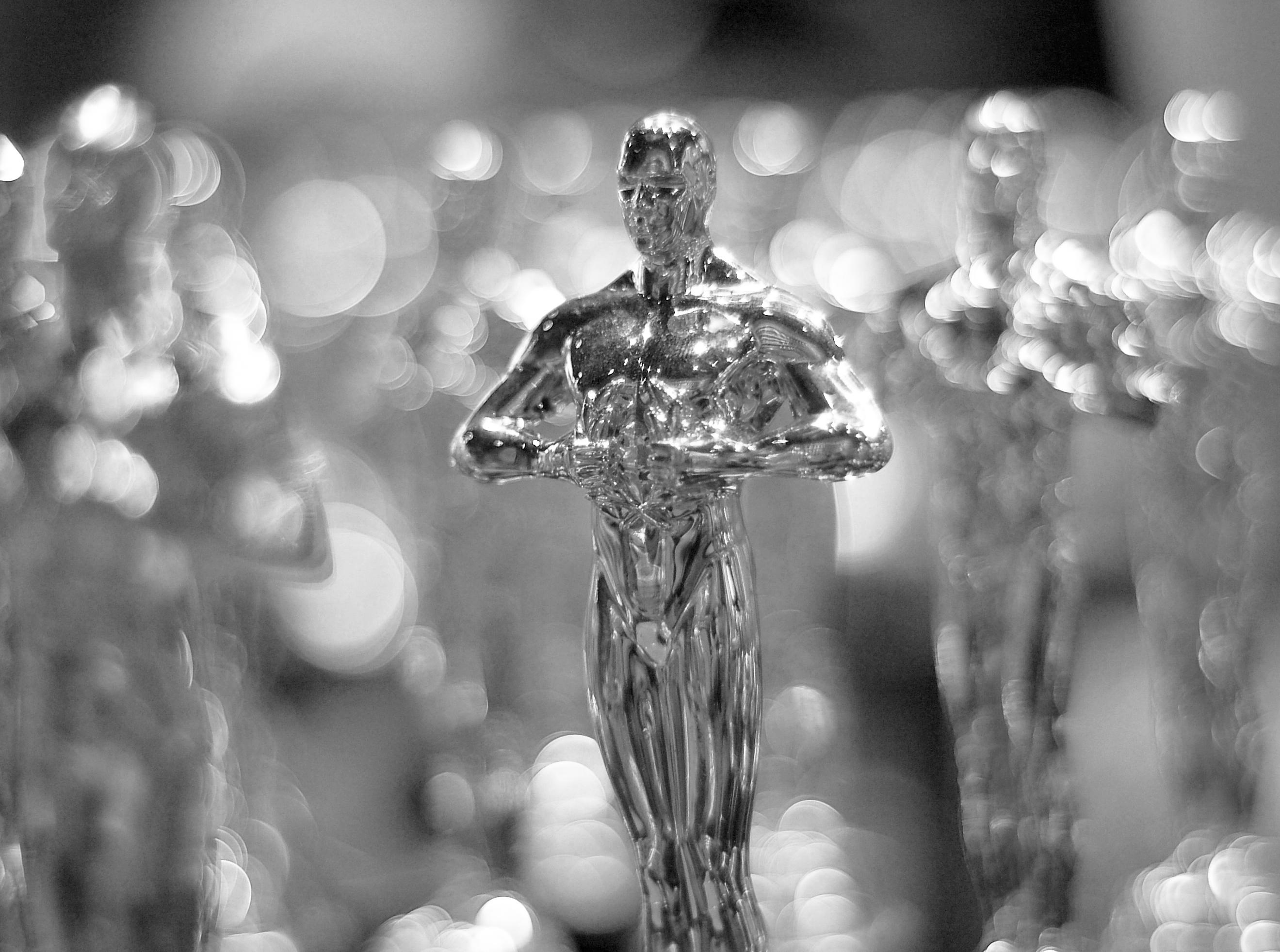 NANDINI NAIR
NANDINI NAIR
Netizens’ knee-jerk reaction to the 96th Oscar nominations revolved around one question: Will it always be a world for the Kens’ and never the Barbies’?
This year’s Academy Award nominations split cinephiles into two camps: one celebrating the nominations of actresses like Lily Gladstone, the first Native American actress to be nominated for Best Actress for “Killers of the Flower Moon” and the other shaken by the lack of nominations for Margot Robbie and Greta Gerwig as the titular role actress and director of “Barbie.”
The conversation on the internet was quick to dissolve from one of absolute ‘feminine rage’ towards the nominations snubbing Robbie and Gerwig, to one that lamented ‘feminine rage’ as the epitome of white feminism by neglecting to celebrate the nominations of women of color such as Lily Gladstone, America Ferrera and Sandra Hüller.
Touching on more than just the lack of intersectional feminism, the conversation also focussed on how “Barbie” itself talks about the need for equity and representativeness, especially in a world where women need to stand together rather than be pitted against one another.
This discourse has taken on so many facets in just a few short days and left me wondering: What do the Oscars stand for? Do they stand for excellence in the field of film and media, or has their purpose morphed into something else altogether? And what does that mean for those of us at home watching?
The Oscars were conceived as a way to honor outstanding achievements in all facets of motion picture production. Pushing for higher quality and deliverance in the field of motion picture, the awards encouraged those in the field to do more and to do it better than ever. It was, in fact, one of the main goals of the Academy of Motion Picture Arts and Sciences (lovingly known as the Academy) after being
incorporated in 1927. While the first-ever Oscars in 1929 lasted a mere 15 minutes, today the award ceremony is a three-anda-half hour coveted honor in the industry within the United States of America and internationally. No longer are the Oscars merely about excellence in the field, but rather a deciding ticket on how movies are evaluated and which ones will be re-released. The Oscars have also become a deal-breaker for producers and financiers as well as a deciding criteria for directors, actors and writers. Nominations have been known to not just catapult those who are fresh-faced in the industry but also have been the grounds on which the audience has questioned the choices, values and abilities of actors. Earning a nomination for the Oscars has now become a crucial part of the holistic recognition of one’s work and a decisive factor in how many in the field choose to express and visualize their creativity.
To me, however, using the words “earning a nomination” is odd. The Academy was originally established to mediate labor disputes and improve the industry’s image, but has since evolved significantly. Today, it is recognized as a prestigious organization, distinguished by its coveted merit-based memberships and influential power. This also means that the nominations for most categories are done by members of the corresponding branch; film editors nominate film editors, actors nominate actors and so on and so forth. This process of nominations for the Oscars takes away the feeling of the award being earned because very little is known about the criteria for nominations. The idea of the nominations being earned feels murky when so little transparency is available to those who make up the box office statistics. Since the nomination debacle this year, rallying calls have been made not just for the need for in-
creased representativeness and equity on the silver screen and nominations, but also for a need to infuse that representativeness with intersectionality. No longer is the discussion focussed solely on how many women are being nominated or are present on the silver screen, rather audiences are asking if marginalized voices are being represented, nominated and celebrated.
Some argue that the mixed reactions caused by the nominations tie directly to the intentions of the Academy. Perhaps in its endeavor to keep up with an evolving world, it has, in its capacity, tried to push for representativeness and equity.
However, to me that effort feels inconsequential when audiences choose to focus on the lack of nominations of white women, while completely marginalizing those who have jumped through loopholes to be honored by the Academy. I cannot help but agree with the demands for intersectionality within representativeness and equity.
As a woman who has watched Barbie umpteenth number of times, the snubbing of Robbie and Gerwig hurt — and why wouldn’t it? These women brought my childhood to life while layering it with everyday challenges I have faced since I was a young girl. However, as a woman of color, I believe celebrating the achievements of those who have historically been marginalized is equally important. That is the beauty of ‘feminine rage’: it doesn’t have to be the epitome of white feminism. My myriad of identities allows me to feel a range of emotions. Perhaps that’s a lesson the Academy can stand to benefit from.
Nandini Nair CG ’24 is from Delhi, India. She loves a good ol’ comfort show rerun, her comforters and throw blankets and reading books that take her far away from reality.
Sure, the Optum algorithm might not have been intentionally racist, but it worked in favor of white patients and against Black patients. As it stands, AI should never be a substitute for a doctor’s expertise and knowledge of their patient’s individual needs.
This problem is not isolated to this company or this specific algorithm, but rather reflects a broader challenge in AI. As computer systems increasingly determine critical decisions in healthcare and beyond, the potential exists to automate racism and other human biases on a larger scale than ever before.
patients sustain about $1,800 less in medical costs per year than white patients with the same number of chronic conditions. This leads the algorithm to score a white patient as equally at risk of future complications as a Black patient who has many more ailments. Thus, Black patients tend not to receive the same level of care as white patients, as the algorithm ranks Black patients as a lower priority than they are because they sustain less in medical costs.
However fruitless it is to attempt to eliminate AI, it is essential to understand and acknowledge that AI reflects what exists in the world, including bias. Currently, AI lacks the ability to detect biases or make determinations of how the world should be. That responsibility falls on humans to define. As AI continues to disseminate across all aspects of our lives, there needs to be more accountability and less reliance on AI as the main or sole decision-maker. The pervasive and often overlooked biases embedded in AI demand urgent and ongoing scrutiny, along with meaningful collaboration across disciplines, to prevent the automation of systemic racism and injustice.
Ella Francis PZ ’25 is from Oakland, California. She is currently living in a tent in Kimana, Kenya, conducting research on conservation ecology and wildlife conservation.
IMS’s lack in production courses is discrediting their mission statement
TESS MCHUGH
A week before spring 2024 registration, I did what most 5C students do: I frantically scoured HyperSchedule.io for classes to create various possibilities for an ideal schedule. I ached to get into the media studies classes I had missed out on as a result of bad registration times in the past. As a junior, the process was sure to go a lot more smoothly this time, right? Wrong. The one production course that aligned best with my interests in media studies, Introduction to Video Art, already had over 50 PERMs. My heart sank. To clarify, a production course provides students with hands-on training and instruction from experienced faculty in various aspects of media studies. Media theory and history classes provide students with an in-depth study of the history of one particular medium or grapple with an overview of the major schools of academic thought that have influenced the field of media studies. The mission statement for the Intercollegiate Media Studies Department (IMS) states that one of their main goals is to connect production and theory to enhance students’ media creations. However, the registration battle I keep losing makes this mission statement, and my journey to complete this major, an insurmountable challenge.
I support this department’s mission statement wholeheartedly, but living up to it is harder than it should be. There are only five introduction to production courses offered for all 5C students and they each cover extremely different areas in media. Three of them are classified as art classes (Foundations of 2D Design, Introduction to Digital Art and Intro B/W Darkroom Photo) and they stray somewhat far from my personal focus on television and film. The last two offered are two sections of Introduction to Video Art and I have yet to get an approved PERM. Especially after three consecutive semesters of attempts. With the introductory production course as a prerequisite for intermediate courses, yet another barrier lies right beyond the first. Although there are other captivating production course offerings, such as Cinematography and Intermediate Media Projects, intro to production courses act as a prerequisite for the rest.
So, until I find a way to squeeze myself into one of the two sections of Introduction to Video Art, the intermediate production courses
will persist as a distant fantasy.
I know what you’re probably thinking: I chose to be at a liberal arts college, so why am I complaining? I have thoroughly enjoyed the seven theory and history classes I have taken in the media studies department, but I have not had the opportunity to acquire the hard skills that accompany the history and theory I have learned. The hard skills in media studies are what will broaden a media studies student’s career options in the field. With more knowledge on how to perform essential tasks in the realm of media, the more clarity they will gain on what career path they want to pursue following their degree.
The primary problem: There is an unbalanced ratio of theory and history classes to production classes.
It’s crucial for IMS to acknowledge that the addition of more production courses does not alter the liberal arts focus. I am not asking for a more professional approach to the media studies major, but rather more opportunities to learn how to connect my understanding of media theory and history to physical achievements and tasks in media studies.
And because this problem stems from registration difficulties, all I’m really asking for is more intro production classes.
I am not alone in my desire for more hard skills acquisition opportunities. With Claremont’s proximity to Los Angeles, one of the biggest media hotbeds in the world, one would expect the resources of IMS to be superb. Still, other students in the media studies department have echoed my desire for more production course sections. Students in some other departments are sounding the hard skills alarm, too: Many English majors are eager for more journalism class offerings so they too can apply their writing skills to a tangible practice.
After hearing about my peers’ schedules, it’s clear that hands-on classes are not just an upperclassman privilege. I know my time will come to take a production course, but I can’t help but feel behind as a second-semester junior who has not gained many hard skills in media studies. It’s time for this liberal arts college to support its liberal arts students.
The addition of more introductory production courses would accomplish this by allowing students to take the classes they need sooner. IMS, and all 5C majors, should consider these beneficial ripple effects — and please accept my Introduction to Video Art PERM.
Tess McHugh PO ’25 is from Denver, Colorado. She loves watching Succession, spending time with her twin sister, and eating Trader Joe’s Peanut Butter Cups.

February 2, 2024 PaGe 7 Opini O ns
Q u INN N a CHT r I eb • TH e ST u D e NT LIF e
CO ur T e S y : LINCOLN b L ue S
Q u INN N a CHT r I eb • TH e ST u D e NT LIF e
Dear SNL, Jacob Elordi is more
than just a sexy man
GRACE KIM
Saturday Night Live (SNL), the New York late-night comedy show, has built upon its repertoire of iconic sketches and wealth of famous comedians since its debut in 1975. SNL’s most recent episode, however, undermines the show’s integrity through buzzy content that encourages low-hanging offensive humor and disappoints the artistic authenticity of SNL’s comedic legacy.
The announcement of actor Jacob Elordi as host and singer and actress Renee Rapp as musical guest garnered much internet hype for the first show of 2024 on Jan. 20. Seeing as the rapidly-rising celebrities have starred in two of the past year’s most viral movies — Elordi’s Saltburn and Rapp’s Mean Girls — the choice seems more promotional than comedically minded.
SNL’s new content is beginning to polarize its wider audience and dedicated viewers are noticing.
“There’s a common perception that [SNL] has gotten worse and that it’s already peaked,” Natalie Lessin SC ’27 said of the impact SNL has had on her life.
Lessin first watched SNL with family while growing up and finds value in how the show exhibits actors “in a new light by attempting comedy.’” Even so, she and her friends find the recent attempts at content aimed at Gen Z “cringy and hard to watch.”
I found much more humor in sketches where Elordi had the creative freedom to showcase his talents rather than his looks — but they were few and far between. And that isn’t always the case.
Think Timothée Chalamet or Adam Driver, two actors who have a large internet following and have garnered esteem for their appearances, but who have also had successful SNL performances. As hosts, their episodes were comedy-focused and enhanced by their on-screen experience. Elordi is widely known for his serious roles in dramas like “Priscilla” and the hit show “Euphoria,” which showcases how seamlessly he can switch between accents and take on unexpected characters. Despite their ability to provide this range for other actors, the SNL writers failed to highlight Elordi as more than his appearance.
In typical SNL fashion, Elordi’s episode began with the “Mono -

logue,” which sets the viewers’ first impressions for what’s to come. Elordi introduced himself, referencing “Saltburn” and its surrounding internet discourse, then opened up questions from some intentionally placed cast members in the crowd. Rather than receiving thoughtful inquiries, Elordi was immediately addressed by his internet-given title of “babygirl.” This trending term ironically describes traditionally attractive males with rugged looks whom fans sympathize with because of their cute, soft personas. SNL’s jokes are known for being satirical and self-referential, but at some point, the jokes became painfully repetitive material that is only practical for its viral qualities on social media. Compliments to Elordi’s physical appeal became SNL’s guilty use of this tactic. The theme of Elordi’s visual allure forcing women to sacrifice

their morals became a common feature of his next few sketches. Elordi plays almost the same character in “Crown Your Short King” and “Women’s AA Meeting” — an infantilized man whose devastating looks put a spell on the women around him. Although the sketches may be entertaining in their outrageousness, they still send the same message as the monologue, which is, once again, that Elordi’s fame boils down to his look. For such a highly celebrated comedic show with an ensemble of talented performers and writers, recurrent jokes are frankly disrespectful to the show’s professionalism. SNL was remiss to misuse precious screen time with what had the potential to be more meaningful and clever comedy.
Sketches and dialogue on SNL have trended towards social media and online appeal and this new clickbait content is very sur-
face-level. SNL is now more conscious of views, likely in light of the decline of live television viewership and with the rise of streaming services providing readily available content. SNL has long established its role in our cultural zeitgeist as an American institution. These sketches are created to reflect our collective thoughts and have become tantamount to American humor. Consequently, they are also highly influential upon our cultural moods and attitudes. As the jokes get more shallow and faux parodic, we are encouraged to disregard the importance of self-examination in our own lives, which is something SNL has historically sought to promote. In attempts to cater to younger or more online audiences, SNL leaves much to be desired by those who have yet to engage in these internet subcultures. All we know
is that, yes, Jacob Elordi is tall and good-looking and has nice cheekbones. But what else? Evidently, SNL has nothing more to say. The adults don’t get it and others find it cringe, or possibly worse, not even remotely funny. This leaves a relatively small niche of viewers to fully enjoy what the writers perceive as Gen Z-tailored content and even then, what do they gain from it? Although flashy concepts may bring in views, they don’t necessarily send a valuable message. SNL should opt to consider the comedic authenticity and introspective social commentary that once brought them their loyal cult following, utilizing the skill sets of their talented actors rather than relying on Jacob Elordi’s chiseled face.
Grace Kim SC ’27 is from San Diego, California. She loves listening to movie soundtracks, eating sour candy and reading Letterboxd reviews.
OFF THE RECORD
PaGe 8 February 2, 2024 Opini O ns
Q u INN N a CHT r I eb • TH e ST u D e NT LIF e
FreaKy FrIeND FaCTOry: A COMIC BY SASHA MATTHEWS Akshay Seetharam 1 2 3 4 5 6 7 8 9 10 11 12 13 14 15 16 17 18 19 20 21 22 23 24 25 26 27 28 29 30 31 32 33 34 35 36 37 38 39 40 41 42 43 44 45 46 47 48 49 50 51 52 53 54 55 56 57 58 59 60 61 62 63 64 65 66 67 filing, and one ____?" knows?) helper 26 Liz Warren brainchild 27 Nabisco treat 28 Nevada city 45 A vacuum, dam, and president 46 Art Deco designer
Crossword: Inauguration Chodosh Pickle chips
Akshay’s
Reneé Rapp Anxiety from overcaffeination Priya Junnar Malott lunch a KSH ay S ee TH ara M • TH e ST u D e NT LIF e ACROSS 1. Quack company? 6. Middle March? 10. One who crosses the line? 14. Conflict 15. Seafaring fish or captain 16. Figure skater Lipinski 17. Like 60A and its associates 19. TV type 20. More irritable 21. Charring 23. Tomato sauce brand named for a famed restaurant in East Harlem 25. Author Daniel of Robinson Crusoe 26. Necessary components, or, seemingly the only columnar decor for 60A architects? 32. Dobby, through sock transferral 33. Island-dwelling indigenes of Bolivia 34. Half of Caesar’s D 37. Remain undetermined 38. Pops, to tots 40. Dynamic start? 41. Heckler’s holler 42. Queue 43. Sleeper’s woe 44. Deprived of will power? 47. Lawyer’s filing, but often not autological 50. 1/760 of an atmosphere 51. Least faty 54. Earache 59. Doctrines of communes and capital 60. Member of one 17A 62. “¿Quién ____?” (Who knows?) 63. Toledo’s lake 64. Allayed 65. Disturbance 66. Carl Sagan’s subj. 67. Many a grandparent DOWN 1. Bank no. 2. Ice sheet 3. Online hookups? 4. Mgr.’s helper 5. Sang in church 6. Openings 7. Trinity that Florida’s gov. hates 8. Australian war-winners 9. They like it hot? 10. Stocks 11. Home of Eureka and Aromas: Abbr. 12. “There _____ accidents,” per Master Oogway 13. Sheriff’s star 18. Raise 22. Citrus drinks 24. Like 906 of 60A in 2022 26. Liz Warren brainchild 27. Nabisco treat 28. Nevada city near Tahoe 29. Flanders or Kelly 30. 60 minuti 31. Rejections 34. Small price to pay 35. Manitoba native 36. Unit of laundry 38. Dante’s hellish city 39. Darth Vader, to Padmé 40. Communication standard-fare for a web dev. 42. Haim, to Tevye 43. In formation 44. Not as bright 45. A vacuum, dam, and president 46. Art Deco designer 47. Ignorance, idiomatically 48. Convened anew 49. Metric feet 52. ____ butter 53. Slanders 55. Texter’s recognition of humor 56. Air force? 57. Notion, in Nantes 58. Delivery dest. 61. Slowing, to Schumann: Abbr. IN IN IN OUT OUT OUT
Raw emotion, drama and photo finishes mark the glory of intramural dodgeball
OWEN KOBETT
Two teams stare each other down in the silence before the match. In the middle of the floor between them is a line of black orbs, colloquially known as dodgeballs. Students on either side size each other up in the second before they get the signal to leap into action. Upon hearing the whistle, their toes fly off on the line and the arena transforms into a frenzy of chaos.
Intramural dodgeball is one of nine intramural sports hosted by Pomona-Pitzer Recreation. Their league is split up into seven teams ranging from five to eight players, united to battle on the CARW gym floor.
Dodgeball is hosted from 7 p.m. to 9 p.m. on Tuesdays throughout the spring season. It is a well established intramural sport, consisting of both a regular season and a postseason that ultimately culminates in a final championship.
One dodgeball squad, the Average Joes, is made up entirely of first-years. According to one of their members, Noah Pershing PZ ’27, the team’s passion stems from their love of athletics.
“We were all kind of doing as many intramural sports as possible, because we love sports and we like getting active,” Pershing said. “I reached out to, essentially the inner
tube water polo team that I had [in the fall] and said, ‘Hey who wants to get in on dodgeball?’ And they were all in.’”
Another member of the team, Leo Godsberg PZ ’27, agreed that dodgeball was a fun way to stay active. He spoke about how he and his teammates prepare for their competitions.
“It’s not the easiest thing to practice for,” Godsberg said. “But a lot of us, we go to the gym, we lift weights, I guess.” Harold Fuson PZ ’26 corroborated this, noting their frequent presence.
“Yeah, I see those guys putting in work,” Fuson said. The Average Joes were scheduled
to play their first game on Jan. 23, but their opponent, the Dodgydiggers, forfeited the match. However, the Joes attempted to sharpen their skills by splitting into two teams of their own. “We played ourselves,” Pershing said. “It was really, really fun. We played just to five, my team went up by two and then they came back too

aDaM aKINS • THe STuDeNT LIFe
From the top! Tamasha looks to wow in end-of-year showcase
SENA SELBY
Slip on your dancing shoes! Tamasha, the 5C Bollywood Dance Club, is gearing up to host its annual end-ofyear showcase, aiming to encourage students in Claremont to celebrate, appreciate and participate in South Asian dance.
Sanskriti, the biggest student-run 5C dance showcase, will take place April 5 at Bridges Auditorium at Pomona College and will include over 100 dancers from all five colleges in a showcase of a diverse range of choreographed routines. The event will highlight Tamasha’s inclusive environment and unique combination of dance styles.
Sanya Dhama PZ ’24, one of the co-presidents of the club, emphasized the positive effect of the diversity of the students who participate in the showcase.
“You’ll see on stage that it’s not just Indian people or people from South Asian descent,” Dhama said. “We’ve really tried to open [the showcase] to everyone so it becomes a really cool opportunity [for everyone] to be able to engage.”
Beyond fostering inclusivity within its members, according to some members, the significance of the club’s name represents its welcoming environment. According to Reina Bhatkuly HM ’25, Tamasha translates to the English word “spectacle.” Bhatkuly said she likes this name because she believes it represents how all people can share a spiritual connection through dance and energy.
“We just come together and try to celebrate the love of being and salvation,” Bhatkuly said.
On top of Sanskriti, Tamasha hosts another South Asian dance festival, Diwali, in the fall. Last year’s performance took place on Nov. 12. Diwali, is the biggest holiday in India and is observed by both Hindu and non-Hindu communities. According to PBS NewsHour, although its origin story differs across regions, its primary theme is the triumph of good over evil. Bhatkuly said that her desire to connect to others during the holiday is what drew her to the club.
“Coming from India, I yearned for that space, especially at a small school,” Bhatkuly said. “It’s really easy to feel isolated during Diwali, because you do something at home, but when you’re here, you don’t have that. Tamasha became that space where I could go and celebrate something that was meaningful to me growing up.”
Drishti Thakur SC ’24 is also co-president of the club. She said that she knew about the club before applying to Scripps. Having danced from a young age, Thakur said she shared a bond with her mother through Bollywood dancing. She said she knew she wanted her heritage to be a large part of her college experience and that the club has lived up to her expectations.
“One of the [application] essays was ‘Why Scripps?’ and I wrote about Tamasha because I’ve been interested in Bollywood dancing since I was 10 years old,” Thakur said. “I knew that Tamasha would be an important part of my life. The minute I stepped on campus, when I went to my first practice as a sophomore, I felt like I belonged.”
The club’s focus changes throughout the year, depending what their upcoming goals are. During the fall semester, Tamasha focuses on hosting open practices and workshopping for dancers of all levels. The club’s choreographers create and teach dances incorporating elements from Bhangra, Garba, semi-classical dances, other Pakistani and Indian regional dances, even incorporating elements of hip-hop and pop.
However, in the spring semester, the club spends their practices preparing for Sanskriti. Thakur said it is this year’s closing act that she is most excited for.
“I’m really excited because after doing work for an entire year … when we finish that dance, it’s going to feel like such an accomplishment,” Thakur said.
Dhama said she hopes that this year’s showcase will bring new people that are interested in dance. She said she wants all students to participate and learn about this culture.
“It becomes difficult to understand what the line is between appropriation and appreciation,” Dhama said. “I think something that I really want to push through dance is coming together, dancing with people of all different backgrounds and doing it in a respectful way where you’re putting your soul, energy and passion into it. Appreciation is being a part of something, so I really encourage people to not overthink anything and just really be there and respect the culture and the space and really embrace the community.”
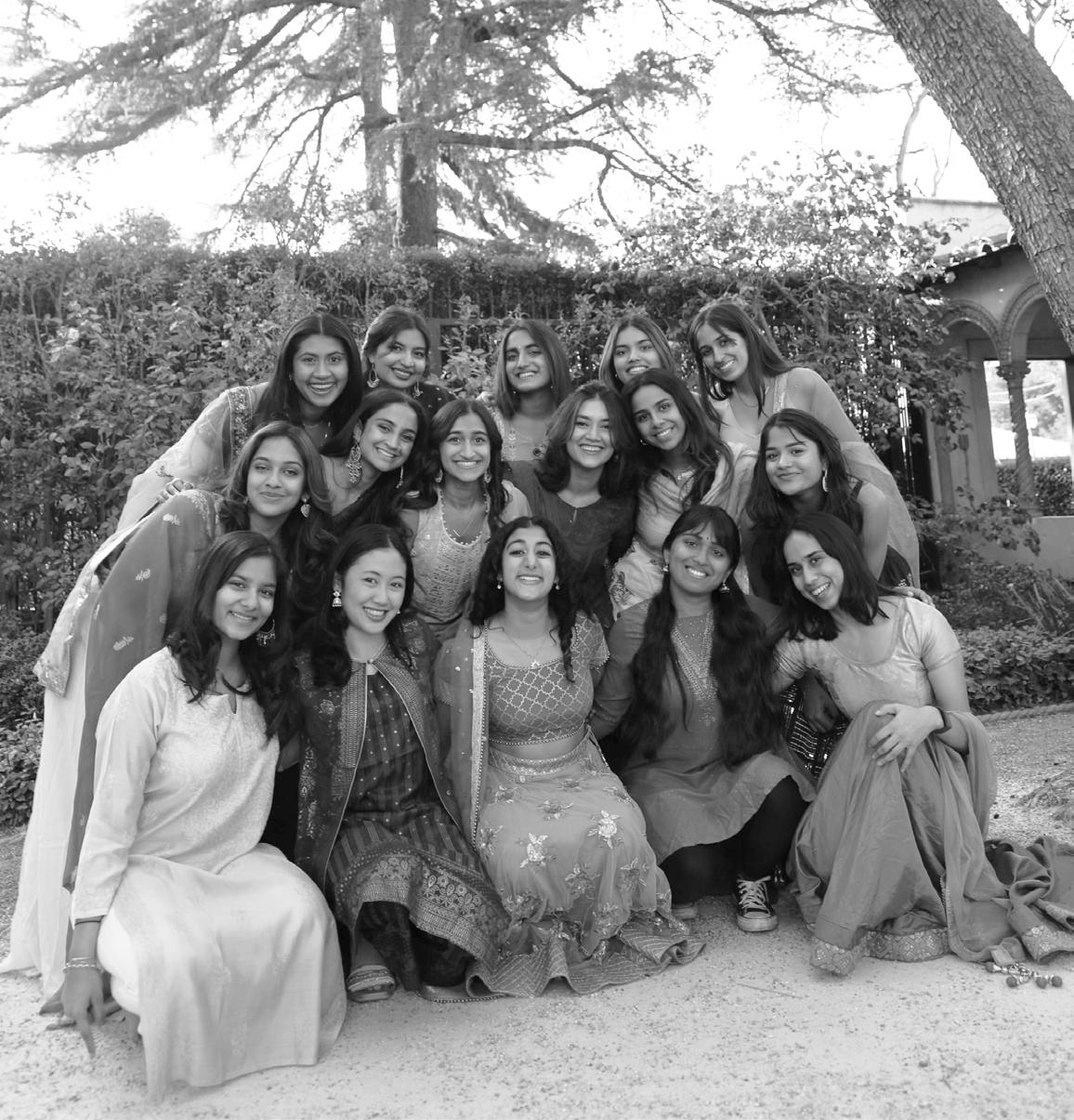
but it was really fun. We’re all really excited for our actual first game.”
Another member of the team, Ryan Williams PZ ’27, reflected on what it was like to practice while other games were being played around his team.
“The atmosphere was honestly pretty fun and pretty intense for the games that were going on,” Williams said. “It seems like this semester, they upped the rules to make things a little more serious.”
On Jan. 30, the Average Joes faced off against the Untouchables. They arrived clad in their innertube water polo championship swag and the Untouchables had enlisted the help of a videographer to chronicle their journey to the top of the world of IM dodgeball.
Both teams heckled relentlessly and pep talks a la “Remember the Titans’’ sounded from both sides of the court as the teams faced off in the win-or-go-home tiebreaker of five. The battle concluded in the referees taking advantage of the videographer and performing a set deciding video review, crowning the Average Joes as champions with a score of 3-2. Raucous chants of “Whose house is this? Our house” could be heard throughout the CARW as the Average Joes celebrated their win.
Bruins bear-ly scrape by Sagehens in sudden death victory over P-P women’s lacrosse
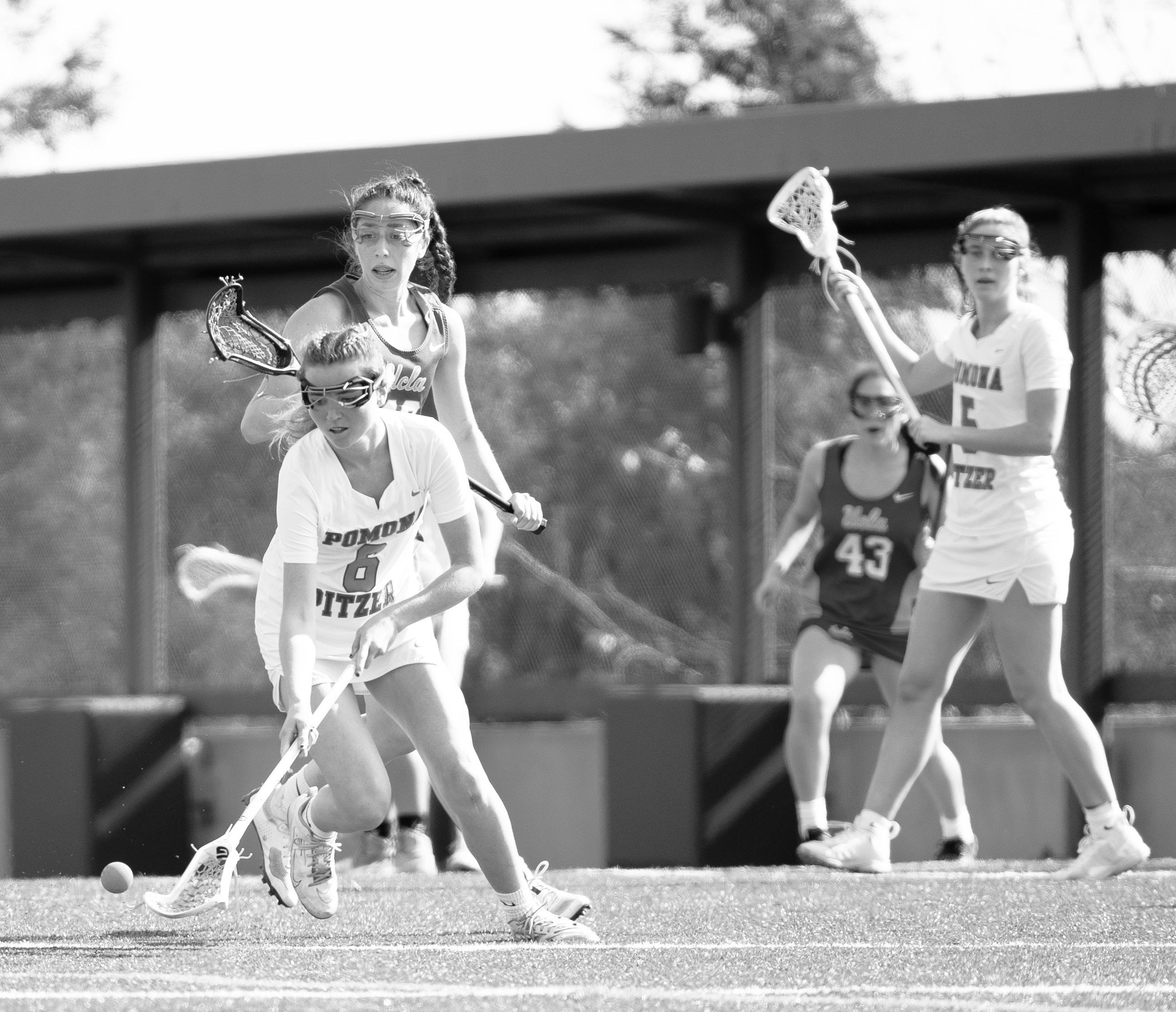
ADAM AKINS
The Pomona-Pitzer (P-P) women’s lacrosse team waged a war against the Division I UCLA Bruins in an unseasonably hot preseason opener on Jan. 27, pushing past regulation time in a thrilling game, but ultimately suffered a 12-11 defeat in sudden death overtime.
The Hens were immediately challenged by the older and faster-paced UCLA side. Throughout the first half, goalie Ruby Loesch PZ ’26 was continuously pushed by their fast breaks. However, after ceding goals early, P-P quickly found their footing, going on a scoring run and earning the lead.
“I felt like we didn’t come out super strong,” River Buechner PO ’26 said. “[So] watching us get up by a couple of goals was exciting and every time Ruby stopped a shot I was thrilled for her.”
First-years Audrey Jacklyn PZ ’27 and Grace Tighe PZ ’27 played a big role in piling on the pressure, breaking into the inner circle in the first half.
“The highlight for me was watching some of the [firstyears] come out and just do so well,” Buechner said. “I remember Grace scored and I was just so excited for her.”
This scoring run led to a stable lead thanks to the offensive discipline of veteran Fiona Lewis PO ’25, who led the team with 72 goals in the 2023 season. Lewis matched the fast breaks and off-ball movement of UCLA and allowed the Hens to find their footing and hold off the Bruins. Nonetheless, the Hens were unable to dominate the first half. However,
unsatisfied with trading the lead back and forth, P-P decided they needed to make some changes.
“At halftime we talked about moving on offense, which definitely helped us put more balls in the net and we also switched to man[-to-man] defense,” Buechner said. “It really helped reduce the cutters they were scoring on.” The second half saw the Hens maintain a steady lead, substituting players frequently, allowing more first-years and underclassmen to see the pitch but continuing to outrun the Bruins’ side. That was until the fourth quarter, where UCLA found the fight to rally, taking advantage of mandown situations and equalizing the score. This drama climaxed when Jacklyn took a hard hit while cutting into the Bruins box and earned a penalty. With 13 seconds left on the clock, Jacklyn was one-on-one with the DI keeper in the first collegiate game of her career. Jacklyn faked right, aiming a shot at the top right corner but sending the ball careening off of the goalposts.
“I thought we were going to win off of that,” Buechner said. “But those pipes [the goal posts] were killing us. I know it’s great, we’re literally hitting the actual goal, but they’re just not going in.”
Tied at 11-11 going into sudden death, the Bruins led two succinct attacks on P-P’s goal, challenging Loesch to make a diving save the first time, but ended the game efficiently with a deadly cut into the arc.
Jacklyn reflected on what her team needs to improve on going forward.
“We need to adjust and get used to the man-up man-down scenarios and perfect our zone defense,” Jacklyn said. “I think UCLA was able to crack our zone a little and seal pretty well on cuts.” The Hens, however, were not flustered and said they were grateful for the chance to play against such tight competition. Buechner also noted that this game gave P-P the opportunity to practice with a league-wide rule change introduced this season.
In an effort to decrease the frequency of injuries, the NCAA board introduced a new form of punishment with the green card. This green card is instituted in a similar way to a penalty in hockey, removing players from the game for one minute after being called for a major foul, such as tripping or illegal use of the stick.
“The green card is very new and kind of annoying,” Buechner said. “I’m not going to lie. It’s annoying to have to sit down for a while on those minor fouls, like tripping, which sometimes just happens.”
This new rule brings big changes to the mechanics of the game, requiring teams across the NCAA to work on optimizing power plays and perfecting new strategies for defending with one less player.
“We’re a very young team, which we knew,” Shoshi Henderson PO ’25 said. “[We] graduated a lot of seniors last year … as an upperclassman, it’s all about just getting adjusted, building chemistry with them and looking forward.”
The Sagehens’ preseason continues with a roadtrip to challenge another DI foe, the San Diego State Aztecs, on Feb. 3.
February 2, 2024 PaGe 9 Sport S
COurTeSy: TaMaSHa bOLLyWOOD DaNCe TeaM
Pitzer freshman lead average Joes before crushing the untouchaballs in a 3-2 set.
Grace Tighe PZ ’27, who scored her first collegiate goal on Saturday, Jan. 27, scoops up the ball during the Sagehens’ 12-11 overtime loss to uCLa
SaraH ZIFF • THe STuDeNT LIFe
5C
The Tamasha Bollywood dance team prepares for Sanskriti, an upcoming
dance showcase.
CMS looks toward SCIAC championship after a record setting OIDFE meet
CHARLOTTE RENNER
& JOSH GEHRING
Heatin’ up and speedin’ up, temperatures and muscles were warm as the track and field season kicked off this weekend at home for Claremont-Mudd-Scripps (CMS). With 10 schools in attendance, excitement was in the air as both the Stags and Athenas embarked down a long road to defend each of their SCIAC titles, making significant strides by walking away with a number of wins.
On Saturday, Jan. 27, CMS hosted their annual Outdoor Indoor Distance and Field Events (OIDFE) challenge, a unique meet in which athletes compete in “indoor” track events on the outdoor track. For some athletes, this is a chance to prepare for more competitive indoor meets that will occur in the following weeks across the country and get reacquainted with the indoor distances. For others, this meet is simply a chance to get back to competing in a less stressful, lower-stakes environment.
For one Stag, Hayden Beauchemin CM ’26, this meet was an early step in his quest to Nationals. Beauchemin showed every step matters, taking first place in the men’s 800-meter race and distance medley relay (DMR), but saying he was keeping his eyes ahead.
“I would love to get that school record and qualify for nationals, but I’m not gonna set my expectations too high,” Beauchemin said. “I think I’m just trying to build my speed up and see what I can do in that. As a team I think everyone is just excited to support each other and get some PR [Personal Records].”
Taking down program records is a common aspiration amongst members of the men’s team this year. Sprinter Nick Teresi CM ’24 voiced this after winning the men’s 400-meter race.
“[I] want to put my name on that record board that we just put up this season,” Teresi said.
Despite running a couple seconds off his personal best this weekend with a time of 50.09 seconds, Teresi’s PR from last season of 47.3 seconds puts him just 0.35 seconds off the school record for the men’s 400.
Athletes of the Week

With wins in the men’s DMR, 400, 800 and 4x400 this weekend, according to Beauchemin, the Stags aim to continue the momentum into the rest of the season. Despite pressure to build on last season’s SCIAC title and runner-up finishes in the men’s 4x400 at the national championship, he said the Stags remain collected and confident in their abilities this season, both looking forward to what’s ahead and enjoying the less stressful atmosphere of preseason.
According to Laura Zimmer CM ’24, ambitions are also high for the Athenas for the indoor and outdoor seasons, explaining her
approach at OIDFE.
“Going into the weekend I was just ready to push myself but also not have any expectations and I think that went well for my mentality, especially as a senior,” Zimmer said. “I’m just trying to enjoy it and today was really fun.”
Zimmer, who placed first in the women’s 1000-meter race and second in the 600-meter race, outlined her goals for both seasons.
“This meet is really preparation for an indoor meet that we’re running in two weeks,” Zimmer said. “We’re gonna be traveling to Boston and I’m just trying to get some more speed in my legs.”
Claremont-Mudd-Scripps
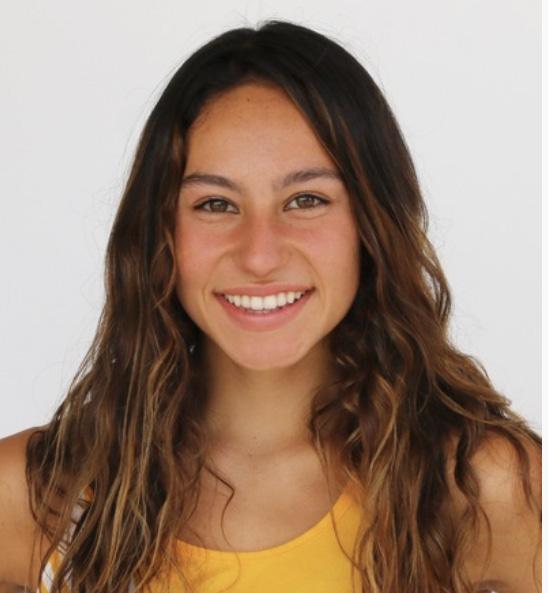
Natalie Bitetti
CM ’24
La Crescenta, CA
Women’s Track and Field
Natalie Bitetti CM ’24 reached her collegiate PR and placed first in the one mile with a time of 5:03.73 during the OIDFE meet on Saturday, Jan. 27, finishing 20 seconds ahead of second place. She earned SCIAC Athlete of the Week for helping secure the Claremont-Mudd-Scripps (CMS) Athenas a team win in their home opener, where they outscored Vanguard by over 40 points. Bitetti accomplished this after she missed last track season while she was studying abroad and has hit the track with an intensity that’s leading the team.
Natalie Bitetti CM ’24, two-time
All American runner, reached her collegiate PR in the women’s mile on Saturday with a time of 5:03.73. She echoed Zimmer’s sentiments, using the meet as a pace setter.
“I wasn’t going in with any super specific goals or anything like that,” Bitetti said. “I just wanted to give a good effort and remember how to push myself. But I’m really happy with the result. I’m really excited to have this as my starting point and I am just gonna build from here.”
For both Zimmer and Bitetti, there is a considerable amount of rust to shed this season. They both
missed last spring’s track season, with Zimmer coming back from an injury and Bitetti returning from studying abroad, so both athletes are looking to make their final track season at CMS a special one.
“I really just want to take every opportunity and try to get the best out of myself [because] I view running as an investment in myself,” Bitetti said. “I just don’t want to have any regrets and spend as much time as I can with my friends. This team is like my best friends.”
The Stags and Athenas have another meet at home on Feb. 3 before heading to Boston University to compete in an indoor invitational.
Pomona-Pitzer
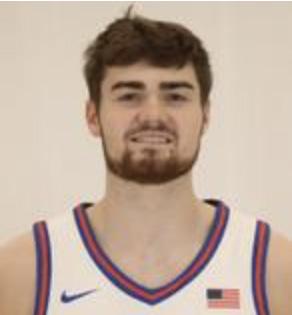
Ty Bergman PO ’25 led the way in the Pomona-Pitzer men’s basketball 93-84 win over Redlands on Jan. 31, scoring 24 points and notching 10 rebounds. 6’7” Bergman also showcased his finesse outside of his normal role in the post, shooting a deadly 85.7% from the field, 30 ticks above his season average. This performance helps establish their position as a top three team in what is shaking out to be a competitive SCIAC title race.
Friday, February 2
Women’s Water Polo @ brown and St. Francis
Men and Women’s Track and Field vs. CMS alumni
Men and Women’s Swim @ uCSb Invitational
Women’s Water Polo @ Harvard (Marist)
Softball vs. Hope International
Men’s Basketball vs. Chapman
Women’s Water Polo vs. Long Island University
Women’s Basketball vs. Chapman
Friday,
Men’s Basketball @ redlands
Women’s Basketball vs. redlands
PaGe 10 February 2, 2024 Sport S SaraH ZIFF• THe STuDeNT LIFe Nick Teresi CM ’24 races in the 200-meter dash during the Outdoor Indoor Distance and Field Events meet on Saturday, Jan. 27.
Sports Calendar CMS P-P Saturday, February 3 Men and Women’s Swim @ uCSb Women’s Lacrosse @ San Diego State University Women’s Water Polo @ bruno Tournament Men’s Tennis @ Azusa Pacific University Women’s Tennis @ uC San Diego Men’s Basketball vs. Caltech Men’s Tennis vs. Irvine Valley College Women’s Basketball vs. Caltech
February 4 Women’s Water Polo @ bruno Tournament, Providence, rI
February 7 Men and Women’s Basketball vs. Chapman
Sunday,
Wednesday,
April 23 baseball @ East Texas Baptist University
’25
Ty Bergman PO
Denver, CO Men’s Basketball
EMMA CONSTABLE, Creative Director JAKE CHANG, Production Editor MADDIE SHIMKUS, A&C Designer AIDAN MA, Opinions Designer NIA CARROLL, Sports Designer AARON MATSUOKA, Copy Chief AJ JOO, Copy Chief ANDREW YUAN, Photo Editor ESHA CHAMPSI, Photo Editor QUINN NACHTRIEB, Graphics Editor ANNABELLE INK, News Editor JUNE HSU, News Editor ELLIE URFRIG, News Associate COURTNEY CHEN, News Associate LUCY JAFFEE, News Editorial Assistant MAYA ZHAN, Arts & Culture Editor PETER DIEN, Arts & Culture Editor ANURADHA KRISHNAN, Arts & Culture Associate JADA SHAVERS, Opinions Editor NANDINI NAIR, Opinions Editor ADAM AKINS, Sports Editor CHARLOTTE RENNER, Sports Editor MARIKA AOKI DEI Editor RENEE TIAN, DEI Editor HANNAH WEAVER, Multimedia Editor ABBIE BOBECK, Multimedia Editor SARA CAWLEY, Business Manager THE STUDENT LIFE BEN LAUREN, Editor-in-Chief ELENA TOWNSEND-LERDO, Managing Editor ANSLEY WASHBURN, Managing Editor TSL’s Editorial Board consists of the editor-in-chief and two managing editors. Aside from the editorial, the views expressed in the opinions section do not necessarily reflect the views of The Student Life. Singles copies of TSL are free and may be obtained at news stands around campus. Multiple copies may be purchased for $0.47 per copy with prior approval by contacting editor@tsl.news. Newspaper theft is a crime; perpetrators may be subject to disciplinary action as well as civil and/or criminal prosecution. Editorial Board Senior Staff
 ANNABELLE INK
ANNABELLE INK
























 NANDINI NAIR
NANDINI NAIR








